- Our Mission

How to Promote Strong Writing Skills in Social Studies
Learning how to write well is essential for effective communication, and students benefit from getting a lot of practice in classes beyond English.

The content of our curricula can be seductive. There are so many fascinating ideas to convey, so many unanswered questions to ask, so many lifelong lessons to learn. Which is one reason why, paradoxically, it can be hard to find the time to teach critical skills like speaking, reading, and writing. Yet this is exactly what we all must do: teach skills through content.
This is true of all disciplines, and in particular social studies. If writing is in the very DNA of English and more foreign to subjects like math, social studies occupies something of a middle ground. The potential for writing is as great as its instruction is inconsistent. What follows are a few simple tips and ideas for teaching social studies students how to write.
But first, why do it? The answer is because those who can write are better able to think critically and communicate effectively. Better able to embrace ambiguity in a complex world, practice empathy, and marshal evidence in support of an argument. In short, because writing makes us smarter.
The Framework
Perhaps the first, most important takeaway is that we should provide as many opportunities as possible for students to write—every week if not every day. The assignments can range from summary paragraphs to entire analytical essays. (Grading is certainly a consideration, but remember, not every assignment merits a copy edit or a score.)
Also consider your students’ yearlong skills progression. Much as you map out the content you’d like to cover, think about doing the same for skills. A partial writing list should include annotations, summaries, analytical paragraphs, source evaluations, analytical essays, and research papers.
When teaching any of the above, and for that matter any other skill, be it playing a C chord, making salsa verde, or shooting a jump hook, the same template applies—explain, model, practice, give feedback, practice. So, for example, describe the elements of an ideally annotated excerpt, show several models, and allow students to practice. Then give them feedback along the way via formative and summative assessments, as formally or informally as you like. Just remember, there’s no way to become a better writer other than to write. Although reading voraciously certainly helps, too.
Foundational and Academic Writing
Foundational writing includes summary, source evaluation, and analytical paragraphs. It’s difficult if not impossible to graduate to more advanced modes of writing without first gaining proficiency in the foundational three.
To summarize is to shorten and paraphrase another’s content, including the main idea and requisite essential details, and excluding one’s own opinion. Set a word limit or percentage of the original, or simply follow the Goldilocks rule, providing not too little information nor too much.
When evaluating a piece of art, document, or film, students should be able to determine both its veracity and whether it’s a primary or secondary source. They should be sensitive to bias and perspective and understand the goal of the work. Look no further than students’ social media swipes and scrolls for the primacy of source evaluation.
The analytical paragraph is much like an analytical essay but in synthesized—or summarized—form. Its essential elements are argument, evidence, and analysis. Exactly the same as its more mature cousin, the analytical essay, which is simply a piece of writing with a beginning, middle, and end, or an idea that is proven over a multiple number of paragraphs.
After ample practice writing analytical paragraphs, students should find the transition to analytical essays, and therefore traditional academic writing, less strenuous and perhaps even not something to hate. And just when they’ve conquered that, you can contemplate teaching them how to write document-based question essays (DBQs) and research papers. The architecture of both remains consistent in terms of supporting an argument with evidence and analysis. They differ simply with regard to the type of evidence presented, namely teacher-provided documents or independent research. The larger point is that once a student is familiar with analytical writing, even in the hypercompacted paragraph, other, more intricate forms of analysis will be much easier to master.
Real-World Writing
And finally, the fun stuff. Think about the writing we encounter in our lives outside of school. Nearly everything you can imagine is fertile ground. The examples are legion: op-eds, book reviews, historical novels, family histories, memoirs, magazine features, white papers, speeches, even visual essays and comics. Authentic real-world writing is almost by definition more engaging, allowing students to find their own voices and their sense of self.
Show students how people in the real world write every day, some for a paycheck and others just for fun. Tell them that their ideas matter and their words hold more power than they may ever know. Try to get students to glimpse the joys of writing. To understand how it sharpens the mind, softens the heart, and feeds the soul. To realize that in addition to being a pleasurable pursuit, writing just might help them change the world.
And if all this is true, my fellow teachers, you might consider writing, too.
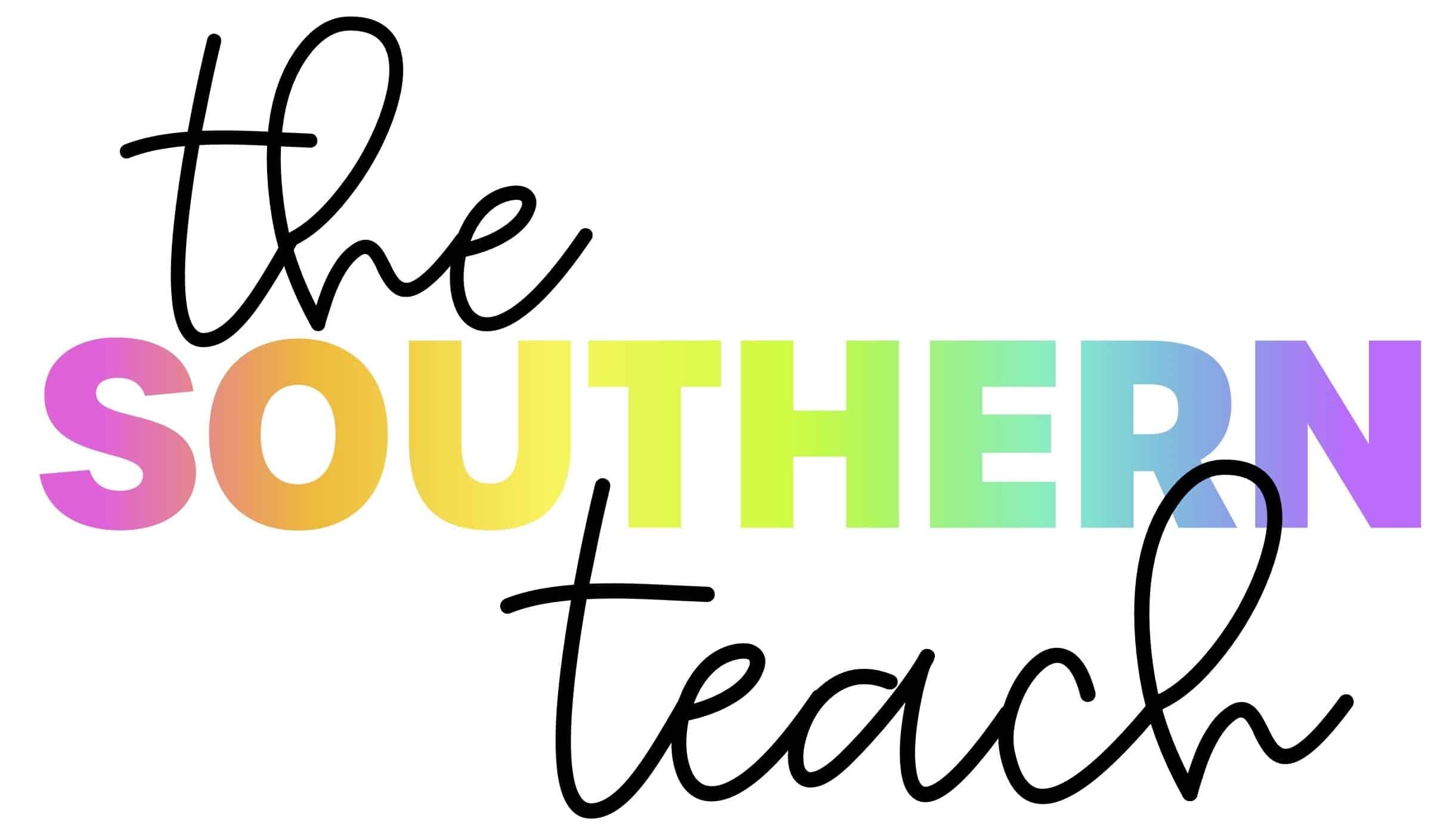
Reading & ELA

Social Studies

Classroom Community

Student Engagement
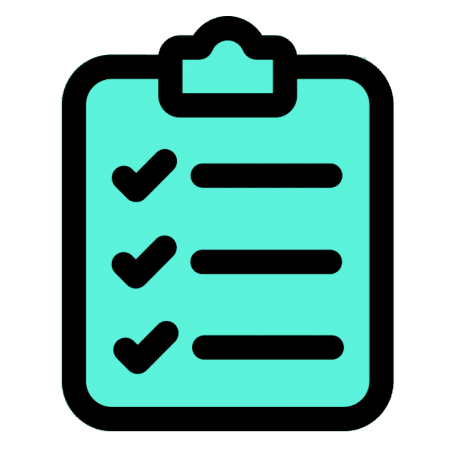
Teaching Tips

- Reading and ELA
5 Fantastic Ways to Integrate Writing with Social Studies
By Kirsten Hammond
Share This Post:
- Facebook Share
- Twitter Share
- Pinterest Share
- Email Share
As educators, we’re constantly on the lookout for innovative ways to engage our students and foster their learning.
In this blog post, we’re diving into the world of integrating writing with social studies. By combining these two essential components, we can create a dynamic and enriching learning environment that benefits students on multiple levels.

Why Integrate Writing with Social Studies?
Integrating writing with social studies might seem complex, but the benefits and possibilities are endless! It’s not just about honing writing skills; it’s about enhancing students’ understanding of historical events, cultures, and perspectives.
Here’s why it’s a game-changer:
1. Deeper Engagement
Writing prompts students to engage with historical events and figures on a profound level. It prompts them to analyze and internalize the subject matter.
2. Critical Thinking
When teachers integrate writing, students develop critical thinking skills. They evaluate evidence and form arguments based on historical context.
3. Unique Perspectives
Writing encourages students to explore events from different angles. It nurtures empathy and helps students understand the motivations and emotions of a variety of sides.
4. Communication Skills
Whether written or verbal, writing enhances students’ ability to communicate effectively. They learn to express ideas clearly, persuasively, and coherently.
5. Creative Expression
Writing allows students to explore their creativity and self-expression. They can craft historical narratives, persuasive arguments, and so much more!

Now that we understand the why, let’s dive into five engaging ways to seamlessly integrate writing with social studies.
1. Incorporate Narrative Writing
Narrative writing brings history to life by putting students in the shoes of historical figures. They can craft journal entries, such as imagining that they are settlers in Jamestown or witnesses to the American Revolution.
Alternatively, encourage them to write historical fiction, using real events as inspiration for their imaginative tales.
2. Embrace Persuasive Writing
Persuasive writing encourages students to form arguments supported by historical evidence.
You can organize classroom debates or assign persuasive essays on topics like the American Revolution or Westward Expansion. Have them craft letters to present-day politicians or “interview” historical figures.
3. Explore Research-Based Writing
Research and inquiry skills are crucial in both writing and social studies. Have students write research papers on historical events, figures, or cultural themes.
Analyzing primary sources and developing well-supported arguments enhances their historical understanding and writing skills.
4. Dive into Expository Writing
Expository writing, or informative writing, helps students explain concepts and present facts.
Encourage students to write informative essays on various social studies topics. They can also create “how-to” guides for cultural celebrations, shedding light on different traditions and customs.
5. Engage in Collaborative Writing
Collaborative writing promotes teamwork, communication, and creativity.
Have students work in groups to create research papers or storytelling projects. They can research different aspects of a topic or develop scripts for podcasts, videos, or plays that explore historical events or other social studies topics .

Assessing Writing in Social Studies
Assessing student work while also having to integrate writing doesn’t need to be daunting. Try these methods!
Develop Clear Rubrics
Create rubrics outlining expectations for each writing assignment. Include criteria like organization, use of evidence, clarity, and mechanics. This provides students with clear guidelines.
Peer Review
Encourage peer review sessions where students provide constructive feedback on each other’s writing. This fosters collaboration, improves writing skills, and enhances the learning process.
One-on-One Conferencing
Schedule individual conferences to discuss students’ writing progress. Address challenges, provide guidance, and offer personalized feedback to support their writing growth.

Resources for Integrating Writing with Social Studies
Feeling inspired to integrate writing into your social studies lessons? Here are some resources and tools to help you get started:
- Library of Congress and National Archive s websites provide access to primary sources.
- Smithsonian Learning Lab offers primary sources, lesson plans, and writing prompts related to various topics.
- Read Write Think features writing prompts designed specifically for social studies contexts.
- Teachers Pay Teachers (TPT) offers a plethora of writing prompts and resources tailored to social studies.
- Digital tools like Padlet , Flipgrid , and Google Slides facilitate collaborative writing projects, peer reviews, and presentations.
Knowing how to integrate writing into your social studies curriculum is a powerful way to enhance learning outcomes. It encourages critical thinking, empathy, communication, and creativity—all while deepening students’ historical understanding.
By incorporating various genres of writing, you create a well-rounded experience that prepares students to become informed and engaged citizens. So, go ahead and weave the art of writing into the rich tapestry of social studies!
kirsten hammond
Kirsten is a former 3rd and 5th grade teacher who loves helping upper elementary teachers by creating resources and sharing ideas that are engaging, research-based, and TEKS-aligned. She is a work-from-home mama of 3 rambunctious little ones and loves running, true crime, and lots of coffee.
You might also like…

Leave a Reply Cancel reply
Your email address will not be published. Required fields are marked *

©the Southern Teach. All Rights Reserved. Designed by Ashley Hughes
- Let’s Connect
- U.S. History
- Government & Civics
- Global Issues
- Student Council & Leadership
- Student Council & Leadership

Essay writing is the one thing I felt the least prepared to teach when I become a social studies teacher. And by least, I mean not at all.
Early in my career, I attended the National Social Studies Council conference specifically looking for sessions on teaching writing. I was shocked to find hardly any.
Is it because we assume students know how to write by high school? Or because it’s regarded as such a fuzzy thing to teach that it’s unknowingly passed over in teacher ed programs and conferences? Or do we still think writing isn’t core to social studies the way it is to ELA? I have no idea.
That’s when I accepted that I was on my own to figure it out.
And it really should not be like that.
Over the years, I created and fine-tuned what I call a DBQ classroom, in which daily lessons build towards an overarching inquiry question and our end-of-unit essay answers it. In another blog post, I outline a broad overview of my DBQ classroom structure so if you’re interested in this approach, check that out before heading back here.
Whether it is US History , or Civics , or Global Issues , if it’s a core subject, I’m using an essay as the culminating assessment to answer the unit-long inquiry. I truly believe writing is that central to learning.
This post follows one I wrote on developing inquiry-based learning units and picks up where that one left off. That’s because these two core pedagogy elements—inquiry and writing—fundamentally belong together.
In this post, I will walk you through the step-by-step process of what “Outline Day” looks like in my classroom—when my students turn their general understanding about a topic into a precise, personalized, and well-supported argument. This is the second-to-last day of each unit, prior to “Essay Day.”
However, these same basic steps work for all types of history and social studies writing: end-of-unit essays, on-demand DBQs or LEQs, and formal research papers.
This is my 6-step how-to guide for scaffolding your history and social studies students in outlining an essay:
1. Deconstruct the essay prompt
2. Recap the truths, not just the content
3. Decide a clear position to argue
4. Choose categories to support a position
5. Select the best supporting evidence
6. Write the thesis
1. Deconstruct the Essay Prompt
Don’t underestimated how crucial this step. Whether it is a unit inquiry question you wrote yourself or one provided for your curriculum, you must teach your students how to break it down.
Some questions to pose to students as you work through analyzing the prompt:
- What topics or content must I cover? What must I exclude?
- What’s considered true and not what I’m arguing?
- What skill must I demonstrate? How do I do that?
- What evaluation must I make?
If you want to go deeper on these 4 questions, check out my blog post on deconstructing social studies essay prompts step-by-step .
If this is a unit-long inquiry, then this deconstructing work happens early on and is also revisited throughout your unit. Personally, I never assign essays unless the question is known and understood all unit long, but sometimes you don’t have that ability.
If you’re preparing students for on-demand essays, like the AP Exam, develop a cheat sheet of your deconstructing system for students to follow. Then practice it with every essay.
One of the easiest and most heartbreaking traps I see AP students, even strong ones, fall into is arguing what the prompt already implies is true, missing the nuances of what the prompt was really asking, because they rushed this step.
2. Recap the Truths, Not Just the Content
After it’s understood what the question is asking, now it’s time to review what it covers. If you created an inquiry unit with a central graphic organizer of at-a-glance notes and students have already loaded it up with what they’ve learned, you won’t need to spend too much time here.
Instead, focus this brief review time on the “truths” about the topic—the broad understandings about which historians, political scientists, and other experts generally agree. The first two deconstructing questions identified these things, so now it’s time to recap the details.
Keep it to 2-3 truths. Basically, you want to show that both or multiple sides of the question have support.
Continuing with our sample Gilded Age question from the last post on building an inquiry unit , “Was late 1800s America a land of opportunity?,” the core truths are that two things—unbelievable wealth as well as abject poverty—existed simultaneously. That is inarguable.
So review with students the most salient examples of both, one then the other. This scaffolds students in two ways. First, it prevents them from getting derailed by arguing that both existed equally, which honestly is just summarizing, because you have reminded students that this is already true and known.
Second, it reinforces everything they’ve learned in the visual of the graphic organizer. In our Gilded Age example we used a T-chart, but it could be a Venn diagram or a cause/effect flow chart depending on the question.
3. Decide a Clear Position to Argue
Pose the prompt once more. In big text on your screen.
And with their at-a-glance graphic organizer in their hands, students should now have a gut reaction answer. If not, they have their sheet to help them decide. Even if a lower-level student has just a few items listed, they can still decide one side or the other.
With our Gilded Age question, a student must either argue “yes” or “no” that late 1800s America was the land of opportunity. They can’t answer “both.” This crucial, fork-in-the-road decision prevents them from summarizing and sets them in a firm direction.
Next, students fine tune their decision into a more precise position. For most essay prompts, this is the argument qualifier —a single “how much so?” word that up-levels their writing significantly.
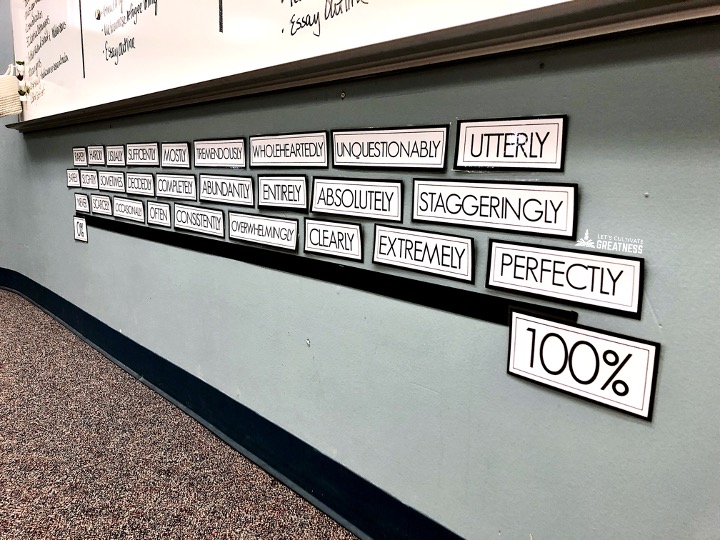
This continuum line of qualifier words on my classroom wall is my strongest tool to strengthen students’ writing and I have a whole blog post dedicated to how I use it daily, not only while essay outlining.
I have students write their two-word position on the top of their outline form—phrases like “somewhat yes” or “decidedly not.” This keeps them laser-focused and on-track, and from a quick across-the-table glance, I know so much about the argument they are forming.
I am a firm believer that good inquiry questions have unlimited right answers and that I’ve done my job well when distinctly different arguments are forming around the room.
4. Choose Categories to Support Position
After those couple of words are committed to their outline form, students now select their body paragraph categories.
The options of possible categories change with the question. Sometimes there’re only three options so everyone has the same three (though argued differently); sometimes there can be up to a dozen options.
To best support students, I suggest sharing a list of possible categories from which to pick. Of course, if students think of something not on the list, invite them to talk it out with you.
For our Gilded Age question, the categories could be groups of people, specific events, or even various popular ideas of the time. Lots of options depending on what you covered.
If you want students to include a counterclaim (and I highly recommend you do so!) in their essays, the clearest way to support them is by teaching it as its own paragraph. Meaning, if a student is arguing the late 1800s was a time of opportunity, their counterclaim paragraph might be on the plight of farmers.
After students label each body paragraph spot on their outline form with its category, I have them next write their topic sentences. Their thinking for choosing those topics is fresh in their mind and this clarity makes the next step even easier.
To recap, by this stage students have very little written in their outline form. Two words of position at the top and three body paragraph topic sentences. But the heavy thinking is done, and a clear path has been laid.
If a student is stuck or needs to talk out their thinking, it’s incredibly easy for me to glance at this uncluttered framework and immediately offer tailored support.
5. Select the Best Supporting Evidence
With precise topic sentences written, students now can much more easily select their evidence for each body paragraph. Provide space on your outline form for however many examples you want them to use.
With our Gilded Age prompt, if a student picked groups of people as their categories and choose the word “hopeful” in their paragraph topic sentence about the late 1800s “New” immigrants, then it’s easy for them to select pieces of evidence that best support that description.
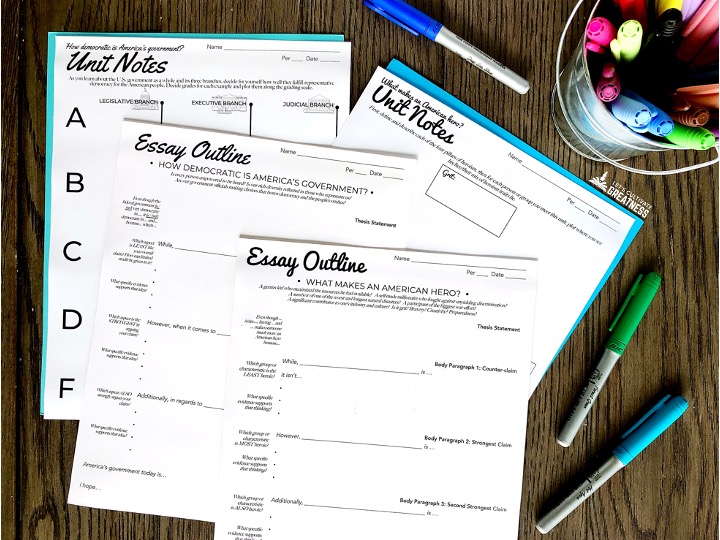
This is another reason why having a unit-long graphic organizer is extremely important. Students already have the best evidence pulled aside and sorted into a T-chart, Venn diagram, or flowchart that directly supports the skill at the center of the question. Now it’s just a matter of curating the pieces that are relevant to the argument they are making.
If a student gets stuck finding examples, you can quickly glance at their topic sentence and point them to something that could work. This keeps them in control of their argument, making a kind of student-teacher synergy that’s almost magical. You’ll also see students use evidence in ways you never thought of.
6. Write the Thesis
Ideally, you’ll have noticed that students are building their essay from the inside out. This order provides so much more accessibility to students at every level.
Since writing in social studies is the process of thinking, the thesis is much more the finale than the beginning. Strong and emerging writers alike benefit from this reversed approach, which also allows for better scaffolding through multiple micro decisions.
However, in the actual essay, yes, the thesis still goes at the beginning.
For years, I’ve used the Even though X, A and B, therefore Y formula with great success. X is the counterclaim paragraph, A and B are the two supporting body paragraphs, and Y includes the argument qualifier. I’ve never met a prompt this didn’t work beautifully to answer.
In my materials I pose a tailored version for students to build from. In our Gilded Age example, it would say, “Even though X was occurring during the late 1800s, A and B were more…, therefore America was/wasn’t <argument qualifier> the land of opportunity which…”
As much as we think formulaic writing isn’t what we want to teach students, we can’t ignore the fact that no formula at all is far more harmful. Strong and middle-leveled students naturally know how to build off of it and lower-level students know they can use every bit of the formula at no penalty. Trust that very few ever do.
After working through these 6 steps, students should have little issue writing a well-organized and well-supported essay.
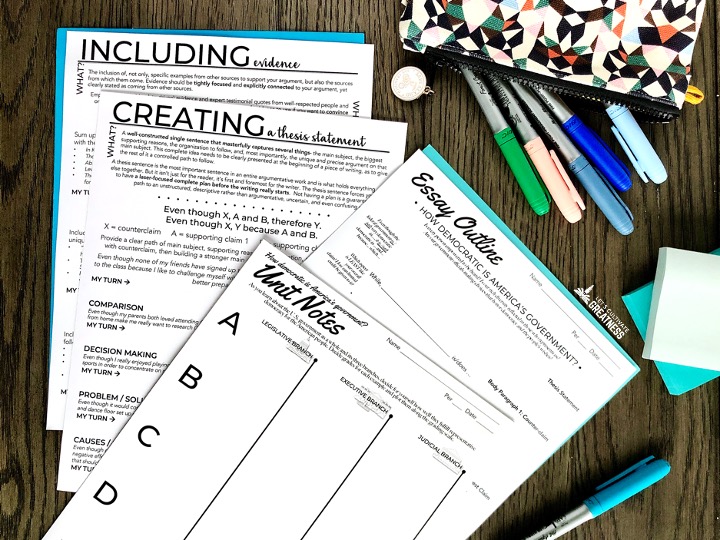
Check out my US History , Civics , or Global Issues courses if you’re interested in making inquiry and essay writing central to your teaching. Both individual unit and full course options are available. Each unit includes all the essay writing supports you’ll need to scaffold writing like a pro—graphic organizers, outline forms, and how-to guides.
Feature image credit: via Pixabay

How to Create Inquiry-Based Learning in Social Studies
Deconstructing essay questions in 4 simple steps.

Related Posts
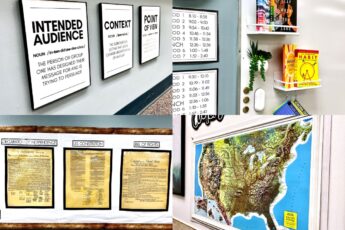
19 Ideas for Setting Up Your Social Studies Classroom


41 Social Studies Writing Prompts
Social studies are an important part of your education. Learning about the social sciences gives you a better understanding of the world we live in today by studying the events of the past.
Reading and then writing about what you learn will give you a better understanding of the past.
Below is a list of social studies prompts that will have you digging up history and gaining a new perspective along the way.
Using This Guide
You can use this writing guide in whatever way makes sense to you. The important thing is that you take the time to research and write.
But if you need help getting started, try one of these ideas below:
- Pick the prompt that’s most closely related to what you’re currently learning in social studies.
- Scan the list and choose the first prompt that catches your eye.
- Pick the prompt about something you know the least about.
The Prompts
- Social studies consist of seven areas: anthropology, economics, geography, history, political science, psychology, and sociology. Which area is your favorite? Why?
- If people had YouTube in 1922, what kind of things do you think they would have posted?
- Write a fictional explanation about what happened to the lost colonists at Roanoke.
- If you could go back in time to any period, which would you choose? Why?
- Pick a historical event before 1950. If the internet and social media were around then, do you think the event would have ended differently? Why?
- How do myths and legends affect modern history?
- Research a female archeologist and write 2-5 paragraphs about her accomplishments.
- Why does the United States have a president instead of a king?
- If you could put a historical figure on U.S. money, who would you pick? Why?
- Why do you think so many people fall for clickbait and false news?
- Who is your favorite person you’ve learned about in social studies? Why?
- Research a California Mission and write 2-5 paragraphs about its history.
- Look at a map of your town when it was first founded. How do you think life was different then?
- What do you think were the three most important inventions of the 1800s? Explain.
- Do you think video games are considered art?
- Research famous protests in history. Would you have participated? Explain.
- Explain the importance of feminism. Use examples from history.
- Do you think it’s important to know where your food comes from? Why?
- Do you think it’s important to know where and how your clothes are made? Why?
- Do you think the U.S. should convert to natural energy where possible? Why?
- Are there any musical instruments you’d like to play? What sparked your interest?
- You are only allowed to listen to one genre of music for the rest of your life. Which do you pick? Why?
- Do you think street art is art or graffiti? Explain.
- What is your favorite painting? Why?
- Why is literature considered art? Explain with examples.
- Do you think it’s important for students to have access to the arts?
- If you could meet any artist (musical, visual, or performing), who would it be? Why?
- Why is it important to respect others’ cultures, but not appropriate them?
- Explain how Black culture has influenced music.
- Compare and contrast the effects of tourism on the environment.
- Pick a country you’d like to visit. Write about its climate, culture, and economy.
- Would you rather live somewhere where it is hot most of the year, or somewhere where it’s cold most of the year? Why?
- How do humans affect climate change?
- Research a common historical misconception . Why do you think so many people believed this myth?
- What is the importance of port cities and international trade?
- Why is diversity important in our society?
- Explain in your own words how the modern alphabet was created.
- What are some good things about your community? What are some things that you would change?
- What is the first historical event you remember? Summarize it in your own words.
- How do you think your childhood is different from your great-great-grandparents’ childhood?
- Research the Bill of Rights. Pick one right that you think needs to be changed or amended. Use examples.
Looking For More?
If you loved these prompts and you’re looking for more ways to help you keep writing, we’ve got you covered.
We also have resources for teachers and parents to help you along the way!
And if you’re looking for something specific, reach out and let us know. We’d love to hear from you.

Doing Social Studies
Social studies for the 21st century, 5 easy ways to integrate writing in the social studies.

Gone are the days in which reading novels and writing essays belonged solely in an ELA classroom. All subjects are now expected to (and should) be integrating and supporting the reading and writing skills that students are taught in Language Arts class.
“But, but . . . I went to college to be a history teacher, not an English teacher. I don’t know HOW to teach ELA!”
That was me. Seriously. I was ready to fight teaching reading and writing skills as long as I could.
Until I learned some simple strategies to help me. This list is meant to help those who are struggling to add reading and writing skills into their classrooms and possibly give some new ideas to others.
Go talk to you ELA Teachers. NOW!
Think about it. If another subject area wanted to start adding in pieces of Civic Engagement into their classroom and needed ideas, you would want them to come to you, right? You are the “social studies” expert. Why wouldn’t you be running down the hall to see the “reading and writing expert” in your building? Go.
Tell them you want to start including more writing skills in your room. Ask them what language they use. How do they teach the kids to structure a paragraph? What grammar skills are they focusing on this year? Trust me . . . depending on the year it could be different. Last year, our 7th grade ELA teacher really focused on capitalization of proper nouns. I was able to help support that. The kids knew it.
Piggy back off of what they are doing . . . Have they taught supporting evidence with quotes from sources? How do they want students to cite their sources? What are some simple strategies for locating evidence within text? Anything that you can say that reinforces what your ELA teacher is doing will make it easier on both of you
Start with what you know
This is the first thing I did. I started requiring the kids to write in complete sentences. I know that one. I don’t know exactly what year the kids are taught how to capitalize the first letter, subject, verb, and end with punctuation. But they know it before 7th grade. Unless it was specified on an IEP I started counting off for those simple errors.
You see, kids came to my class thinking “it’s not English so I don’t have to do things correctly.” Once they knew I was taking points off for not writing correct complete sentences, they magically started doing it correctly.
I love using acronyms for the classroom. Especially when it’s short and easy to remember. TAG is great because it gets kids writing better essays with MORE than just the basic “it happened on 7-4-76.”
This is automatically a two sentence response, but it’s more than just having the kids respond with two sentences. It forces them to give more detail. TAG requires students to go back into the text and find something else to say about the topic.
I would be lying if I said the students cheered when I told them TAG had to be used to answer questions but 100% of the time, their answers are better. So I like it and we use it!
Poetry is where it’s at!
If there’s one thing about incorporating ELA strategies that I love, its using various forms of poetry for students to express their understanding of a topic. We use acrostic poems in our “bell work,” haikus to summarize a topics, “I AM” poems to understand perspective, and this year I hope to add “Blackout Poetry” because it is awesome!

As you start trying to add more writing into your social studies classroom, give these 5 things a try. As always with everything on my blog, if you need any copies of anything or want to talk ideas don’t hesitate to contact me @JillWebs on Twitter.
Want more writing ideas? This post is a shorter version of a previous post with more examples found here .
Share this:
- Click to share on Twitter (Opens in new window)
- Click to share on Facebook (Opens in new window)
- Click to share on Pinterest (Opens in new window)
- Click to email a link to a friend (Opens in new window)
- Click to print (Opens in new window)
Leave a Reply Cancel reply
Discover more from doing social studies.
Subscribe now to keep reading and get access to the full archive.
Type your email…
Continue reading
Jump to navigation
- Inside Writing
- Teacher's Guides
- Student Models
- Writing Topics
- Minilessons
- Shopping Cart
- Inside Grammar
- Grammar Adventures
- CCSS Correlations
- Infographics
Get a free Grammar Adventure! Choose a single Adventure and add coupon code ADVENTURE during checkout. (All-Adventure licenses aren’t included.)
Sign up or login to use the bookmarking feature.
- 26 Writing in Social Studies
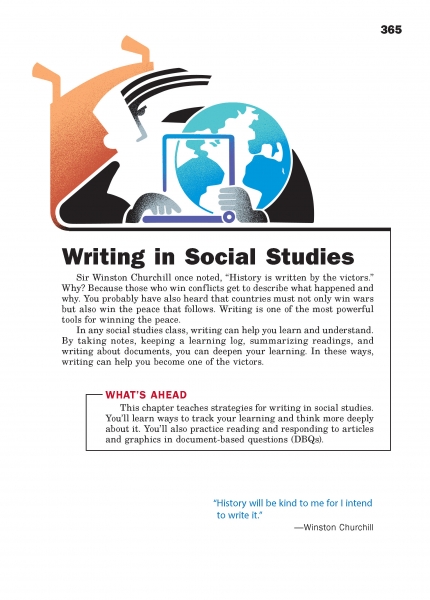
Start-Up Activity
When your students arrive, have them spend five minutes writing about what they learned in class the day before. This exercise will not only reinforce their learning but will also introduce today's topic.
Have volunteers share their observations. No two will be alike. Some will be more in-depth and accurate, others more general and inaccurate. Some will emphasize one point, and others another. Students may nod and smile when someone recalls something they had forgotten. Point out that yesterday's class lies somewhere in all of those accounts—multiple reports from eye-witnesses of the events of the previous day.
Writing in social studies involves exactly this process, synthesizing the perspectives of many to discover what happened and why.
Think About It
“History never really says good-bye. History says, 'See you later.'”
—Eduardo Galeano
State Standards Covered in This Chapter
- CCSS.ELA-LITERACY.WHST.11-12.2
- CCSS.ELA-LITERACY.WHST.11-12.8
- CCSS.ELA-LITERACY.WHST.11-12.9
- CCSS.ELA-LITERACY.WHST.11-12.10
- CCSS.ELA-LITERACY.WHST.11-12.4
- CCSS.ELA-LITERACY.WHST.11-12.5
- CCSS.ELA-LITERACY.WHST.11-12.7
- CCSS.ELA-LITERACY.WHST.11-12.1
- CCSS.ELA-LITERACY.WHST.11-12.1.A
- CCSS.ELA-LITERACY.WHST.11-12.1.B
- CCSS.ELA-LITERACY.WHST.11-12.1.C
- CCSS.ELA-LITERACY.WHST.11-12.1.D
- CCSS.ELA-LITERACY.WHST.11-12.1.E
- CCSS.ELA-LITERACY.WHST.11-12.2.A
- CCSS.ELA-LITERACY.WHST.11-12.2.B
- CCSS.ELA-LITERACY.WHST.11-12.2.C
- CCSS.ELA-LITERACY.WHST.11-12.2.D
- CCSS.ELA-LITERACY.WHST.11-12.2.E
- CCSS.ELA-LITERACY.WHST.11-12.6
- CCSS.ELA-LITERACY.RST.11-12.1
- CCSS.ELA-LITERACY.RST.11-12.2
- CCSS.ELA-LITERACY.RST.11-12.6
- CCSS.ELA-LITERACY.RST.11-12.7
- CCSS.ELA-LITERACY.RST.11-12.8
- CCSS.ELA-LITERACY.RST.11-12.9
LAFS Covered in This Chapter
Lafs.1112.whst.1.2, lafs.1112.whst.3.8, lafs.1112.whst.3.9, lafs.1112.whst.4.10, lafs.1112.whst.2.4, lafs.1112.whst.2.5, lafs.1112.whst.3.7, lafs.1112.whst.1.1, lafs.1112.whst.2.6, lafs.1112.rst.1.1, lafs.1112.rst.1.2, lafs.1112.rst.2.6, lafs.1112.rst.3.7, lafs.1112.rst.3.8, lafs.1112.rst.3.9, teks covered in this chapter, page 366 from write for college, taking notes in social studies.
Use this page to provide students tips for improving their note-taking. Each bolded direction at the top of the page can help students more efficiently and accurately record information from lectures and readings, as well as access it later to prepare for tests. The model notes page at the bottom shows these tips in action, including using graphics to visualize information.
Related Resource Tags
Click to view a list of tags that tie into other resources on our site
Page 367 from Write for College
Keeping a social studies log.
Encourage students to keep a learning log for their social studies class, reflecting on the ideas they are discovering. Provide the tips at the top of the page to help them get the most out of their logs. Present the example entry at the bottom of the page, noting how the writer thinks about the topic and connects it to other learning.
Have students get a start by reflecting for ten minutes on what they most recently learned in class.
Page 368 from Write for College
Guidelines: summarizing a social studies argument.
Summarizing helps students reflect on new learning, capture it in their own words, understand it, and synthesize it with other learning. Use this page to guide students through the process of summary writing.
Before they write their own summaries, have students read and discuss the sample article and summary on page 369.
Then have students use SQ3R to closely read a current-events article or part of a social studies textbook. Have students identify the focus of the reading and the main supporting points.
Present the suggestions for writing the beginning, middle, and ending of the summary.
Then help students improve their work by quipping them with the Checklist for Revising and Editing Social Studies Summaries .
Page 369 from Write for College
Article and summary.
Have students read the social studies article, "The Great Chain of the Hudson." Then have them read the summary. Point out that the topic sentence names the article and author and provides the focus. Then the body sentences capture the main points of the article. Also, note that the summary is less than a third the length of the original and is rendered in the writer's own words (paraphrased).

Page 370 from Write for College
Guidelines: writing an editorial.
Use this page to help students write editorials expressing opinions about current events, historical periods, or social concerns.
Before students write their own editorials, have them review the editorial on page 371.
Then have students choose a topic that relates to their current studies, research it, and form an opinion.
Once they are ready to draft their editorials, lead students through the suggestions for creating opening, middle, and closing parts.
Afterward, provide them the Checklist for Revising and Editing Editorials .
Page 371 from Write for College
Have students read this editorial to themselves. Afterward, ask them their opinions about immigration. What ideas in the editorial swayed them, and what ideas did they find unconvincing? How did the writer express and support the opinion? What social studies topic would they like to express an opinion about?
Page 372 from Write for College
Guidelines: responding to document-based questions.
Document-based questions (DBQs) ask about ideas presented in a series of articles and graphics. Students need to analyze the documents and draw evidence from them to answer the DBQ. Use this page to help students learn best practices for responding to these kinds of questions.
Before they answer their own DBQ, have students review the documents and response on pages 373–375.
When students are ready, provide then a DBQ and ask them to analyze it using the PAST strategy. Then have them use the SQ3R strategy to closely read the documents. After they have done so, they should jot down a thesis statement and a quick list of main details.
Lead students through the instructions for creating an effective opening, middle, and closing.
Then provide them the Checklist for Revising and Editing DBQ Responses , noting that they will not have this checklist in real test environments. However, these are the kinds of questions they should ask themselves as they revise and edit.
Page 373 from Write for College
Documents 1 and 2.
Before students engage these documents, have them analyze the prompt on page 375:
We live in the Anthropocene—when humans affect all life on earth. How should we interact with nature? Write an essay expressing your opinion and use evidence from the documents to persuade your generation.
Keeping that prompt in mind, students should closely read these two documents. Ask them to think about the main point and supporting details of each, as well as how they relate to the question.
Page 374 from Write for College
Documents 3 and 4.
Have students closely read these documents, thinking about the document-based question on page 375. Ask them to note the focus and main points of each document.
Page 375 from Write for College
Document-based question.
Ask students to reread the DBQ at the top of the page, and then closely read one student's response. Afterward, lead a discussion of the student's thesis statement and main supporting points. Also, ask how the writer uses and credits evidence drawn from the documents.
Encourage students to use a similar approach when they answer DBQs.
Page 376 from Write for College
Using graphic organizers.
Graphic organizers help students visualize information in social studies. They capture ideas in notes, gather details during research, organize information before drafting, and allow students to think critically about issues. You can direct students to the minilessons for even more help with these graphic organizers.
Sequencing with a Time Line
Use time lines for critical thinking.

Evaluating with a Pro-Con Chart
Analyze good and bad with a pro-con chart.

Analyzing with a Cause-Effect Chart
Analyze causes and effects of any topic.

- 01 One Writer's Process
- 02 Traits of Writing
- 03 Prewriting
- 05 Revising
- 07 Publishing
- 08 Improving Sentences
- 09 Building Paragraphs
- 10 Mastering Essays
- 11 Writing with Style
- 12 Writing Terms and Techniques
- 13 Personal Writing
- 14 Narrative Writing
- 15 Explanatory Writing
- 16 Argument Writing
- 17 Literary Response Writing
- 18 Creative Writing
- 19 Conducting Research
- 20 Summaries, Paraphrases, and Abstracts
- 21 Report Writing
- 22 Writing the Research Paper
- 23 MLA Research Paper
- 24 APA Research Paper
- 25 Writing in Science
- 27 Writing in Math
- 28 Writing in the Workplace
- 29 Reading Nonfiction
- 30 Reading Literature
- 31 Reading Graphics
- 32 Listening and Note Taking
- 33 Speaking Effectively
- 34 Building Vocabulary
- 35 Writing on Demand
- 36 Answering Document-Based Questions
- 37 Taking Exit and Entrance Exams
- 38 Taking Advanced Placement* Exams
- 39 Marking Punctuation
- 40 Checking Mechanics
- 41 Understanding Idioms
- 42 Using the Right Word
- 43 Parts of Speech
- 44 Using the Language
- 45 Student Almanac
- Features for Creative Writers
- Features for Work
- Features for Higher Education
- Features for Teachers
- Features for Non-Native Speakers
- Learn Blog Grammar Guide Community Events FAQ
- Grammar Guide
How to Use Writing in Your Social Studies Classroom

Krystal N. Craiker
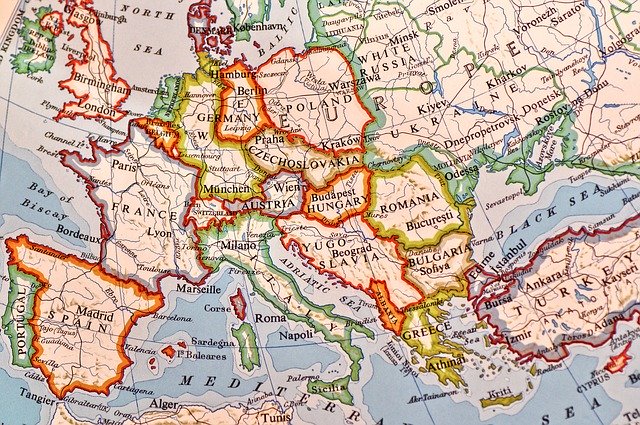
I can’t tell you how many times I've heard some version of the complaint, “This isn’t English class! Why are we writing?”
It might just sound like something unmotivated students would say, which is partially true. But it also reveals a bigger truth: our students aren’t writing enough outside of English class. My students were juniors and seniors! They should have been used to it by then.
My school district had a widespread push for writing across the curriculum. The director of social studies implemented two document-based question essays a year for all students in fourth grade and above. Other teachers balked at these initiatives, and at first, I did, too.
Literacy in America
Writing as an assessment, writing to learn, document-based questions, extra tips for teaching with writing.
As our principals provided more training sessions to help us reach English language learners and build language-rich classrooms, I began to hear a mantra.
“All of us are English teachers.”
No, I wasn’t. I specifically did not pursue a certification in English Language Arts because I didn’t want to teach reading and writing. I didn’t want to stress over the hardest standardized tests; I had enough of that in history!
But the longer I taught—and the more I implemented writing in my classroom—I realized I was wrong. We are all responsible for improving literacy.
The Program for the International Assessment of Adult Competencies (PIACC) does a widespread study of literacy every ten years, with updates to the data coming in more frequently. The most recent data come from 2014. The results are staggering.
More than 50% of American adults read and write at or below a fourth/fifth-grade level. A shocking 17% read and write at below a third-grade level. Only 13% of American adults can read and write at a high school level or higher.
Perhaps the most sobering statistic is that 4% do not have enough literacy to function in our society. If that seems low, think of it like this: in a room of 100 random people, four could not read and write well enough to perform basic tasks in our society.
So, yes, we are all English teachers. Social studies is a reading-heavy subject by nature, but many teachers gloss over writing. I understand that incorporating writing in your class can be overwhelming. Let me share some ideas on increasing the writing in your classroom.
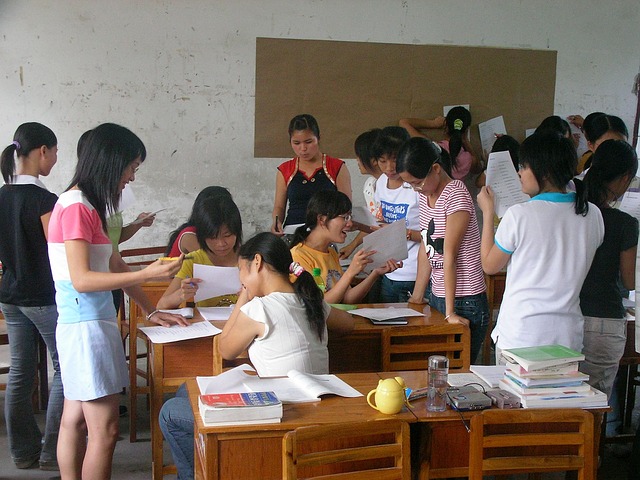
There are a lot of reasons that teachers use multiple-choice tests. They’re easier to grade. It’s easy to compare data. And in the age of high-stakes testing, we have to get the kids prepared for that end-of-year exam.
But only using objective testing does not always give you a good idea of your students’ learning. Some kids are terrible test-takers. Some kids can guess their way through a multiple-choice test by knowing a few keywords. Often, the student may know the answer but get tripped up by the word choice of the question.
Writing tells you not just if they have learned the concept, but also to what degree. Did they forget the year of the Bay of Pigs, but they can describe the events that occurred? That’s pretty high mastery. Did they forget what yellow journalism is or the name of the USS Maine, but they can explain the role that the media played in the Spanish-American War? They’ve got it!
Add a few short-answer questions to your tests. It might take you longer to grade, but you’ll get a better idea of their comprehension.
Use writing as an exit ticket. You can provide a specific question to answer or use a template. I enjoy the 3-2-1 method.
- Write 3 things you learned
- Write 2 things you are confused about OR 2 things you found interesting
- Write 1 question you have
Reading your exit tickets won’t take you long. I used to glance through them for a general idea during passing periods. Sometimes I would immediately notice what I needed to clarify for the next class.
Most writing in the social studies classroom is either formative or summative assessment. But writing can also be used to learn and explore the material. Writing doesn’t have to be only factual. In fact, if you can get your kids personally invested in the content through writing, they will learn even better.
Opinion Questions and Observations
Start a lesson by asking a personal question that relates to the content. In the age of standardized tests, opinion questions can be difficult for students. They are used to having a right and wrong answer. Be patient, and respect what they say.
Here are a few ideas of the types of questions you can ask.
- You are moving to a new place far away, and you can only bring what fits in your backpack. What do you bring and why? ( any lesson with human migration )
- What is something you think should be changed immediately in our society and why? Is it the government’s responsibility to make this change? ( revolutions )
- You and 100 people have landed on a deserted island, and you’ve been selected as the leader. What are the first ten rules that you make? ( Constitution, Bill of Rights )
- Write about a time that you visited someone’s house and noticed that they do things differently than your family. What did they do that was different? How did it make you feel? ( culture, exploration )
We also use many primary sources in social studies. These are great tools for getting your students to write. Ask them to write down their observations in a photograph, painting, or political cartoon. You can provide accommodations based on the level of your students. For instance, lower-performing students can write three observations. The Five Ws (who, what, when, where, why) are great for most students. Advanced students can use AP strategies like APPARTS .
Be sure to include personal opinions and reactions in your primary source writing. If your students don’t know what is happening, have them make a hypothesis. Ask them what emotions the picture evokes. The more personally invested they are, the more they will learn.
Creative Writing
Many students think history is about names and dates, and they miss the idea that history is a story about real people. Creative writing can help bring history to life.
Letters and diary entries are a great way to personalize historical material. After they have a basic understanding of a subject, ask them to imagine they are living during that time. Focus on including sensory details and emotions instead of just facts.
Let’s take a look at a few guiding questions for writing a historical letter or diary entry.
- Who are you?
- What is happening in the world?
- What can you see? Smell? Hear?
- How do you feel and why do you feel that way?

AP teachers are familiar with Document-Based Questions (DBQs). But DBQs aren’t just for advanced students. These essays are a great way to turn your students into historians.
A DBQ provides a selection of relevant primary and secondary sources that support an essay prompt. Using prior knowledge and the available documents, students write an essay. DBQs cover document analysis and teach students to synthesize information in a logical, concise manner.
DBQs might sound daunting, but thanks to The DBQ Project , you can adapt a DBQ for all grade levels and abilities. They provide both full-length DBQs and Mini-Qs. There are many lessons out there for how to teach a DBQ.
Modeling is very important, and methods like Gradual Release (I do, we do, you do) are highly effective for walking your students through the process.
One major concern teachers have about incorporating more writing is the grading workload. But you don’t need to add too much extra time to your grading process. You can have students share their writing out loud or check for completion while they work on other activities. Remember, you don’t need to take a grade on everything.
You are looking for comprehension more than correct mechanics. Encourage good spelling and grammar, but if you focus too heavily on it, the kids won’t write like you want them to. I only counted off for mechanics when I assigned essays like a DBQ. Even then, it was just worth a few points on the rubric. Don’t spend too much time correcting every mistake, and meet your students where they are. If you want to correct spelling and grammar, pick one or two repeated errors to address.
For English Language Learners or other students who require accommodations, provide sentence stems. Always encourage the use of complete sentences to increase literacy and fluency for all students.
How will you incorporate writing in your social studies classroom? Share your thoughts in the comment section below.
Editing technology like ProWritingAid provides immediate, personalized feedback that will help students to better understand grammar and writing techniques.

Be confident about grammar
Check every email, essay, or story for grammar mistakes. Fix them before you press send.
Krystal N. Craiker is the Writing Pirate, an indie romance author and blog manager at ProWritingAid. She sails the seven internet seas, breaking tropes and bending genres. She has a background in anthropology and education, which brings fresh perspectives to her romance novels. When she’s not daydreaming about her next book or article, you can find her cooking gourmet gluten-free cuisine, laughing at memes, and playing board games. Krystal lives in Dallas, Texas with her husband, child, and basset hound.
Get started with ProWritingAid
Drop us a line or let's stay in touch via :
Advertisement
Writing expository essays from social studies texts: a self-regulated strategy development study
- Published: 20 April 2021
- Volume 34 , pages 1623–1651, ( 2021 )
Cite this article
- Alyson A. Collins ORCID: orcid.org/0000-0003-3710-2687 1 ,
- Stephen Ciullo ORCID: orcid.org/0000-0001-6092-8159 1 ,
- Steve Graham 2 , 3 ,
- Lisa L. Sigafoos 4 ,
- Sara Guerra 1 ,
- Marie David 5 &
- Laura Judd 1
1793 Accesses
8 Citations
6 Altmetric
Explore all metrics
This study examined the effectiveness of Self-Regulated Strategy Development (SRSD) to improve students’ ability to write expository essays after reading social studies text. Third-grade general education teachers ( N = 14) were randomly assigned by clusters to SRSD or a business as usual control condition. One hundred and eighty consented students participated in the full study. Teachers in the SRSD condition participated in 12 h of practice-based professional development (PBPD) before implementing the SRSD intervention. They also received 30-min biweekly coaching sessions across the 16 weeks of the study. Initially, teachers provided SRSD strategy instruction in TIDE ( Topic Sentence, Important Details, Explain Details, Ending ) for planning and writing expository essays. Then, teachers spent an additional 8 weeks teaching students to use TIDE for close reading, planning, and writing expository essays using social studies text. Multilevel random effects models indicated SRSD students included more genre elements in their expository essays (ES g = 1.07) and produced essays of higher holistic quality (ES g = 0.72) than control students when writing an expository essay using a source text. Students in the SRSD condition also included more genre elements when writing an expository essay drawing content from memory (ES g = 1.09), and outperformed control students on a norm-referenced writing measure (ES g = 0.79). Findings support implementation of the SRSD intervention in general education classrooms within content-areas and underscore future directions for combining writing, reading, and social studies instruction.
This is a preview of subscription content, log in via an institution to check access.
Access this article
Price includes VAT (Russian Federation)
Instant access to the full article PDF.
Rent this article via DeepDyve
Institutional subscriptions
Similar content being viewed by others

Social Learning Theory—Albert Bandura

Distributed Scaffolding: Scaffolding Students in Classroom Environments
Sadhana Puntambekar
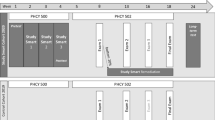
Study smart – impact of a learning strategy training on students’ study behavior and academic performance
Felicitas Biwer, Anique de Bruin & Adam Persky
Alves, R., Limpo, T., & Joshi, M. (2020). Reading-writing connections: Towards integrative literacy science (pp. 313-317) . NY: Springer. literacy science (pp. 313–317) . NY: Springer.
Applebee, A., & Langer, J. (2011). A snapshot of writing instruction in middle schools and high schools. English Journal, 100 , 14–27.
Google Scholar
Ball, D.L. & Cohen, D.K. (1999) Developing practice, developing practitioners: Toward a practice-based theory of professional development. In G. Sykes & L. Darling-Hammond (Eds.) Teaching as the learning professional Handbook of policy and practice (pp 3–32). Jossey Bass.
Bangert-Drowns, R., Hurley, M., & Wilkinson, B. (2004). The effects of school-based writingto-learn interventions on academic achievement: A meta-analysis. Review of Educational Research, 74 , 29–58.
Bernabei, G. (2005). Reviving the Essay . Discover Writing.
Bernabei, G. (2015). Grammar Keepers . Sage.
Beal, C. (1996). The role of comprehension monitoring in children’s revision. Educational Psychology Review, 8 , 219–238.
Bean, T., & Steenwyk, F. (1994). The effects of three forms of summarization instruction on sixth graders’ summary writing and comprehension. Journal of Reading Behavior, 16 , 291–306.
Benedek-Wood, E., Mason, L. H., Wood, P., Hoffman, K., & MacGuire, A. (2014). SRSD for quick writing in four middle school science classrooms. Learning Disabilities: A Contemporary Journal, 12 , 69–92.
Borenstein, M., Hedges, L. V., Higgins, J. P. T., & Rothstein, H. R. (2009). Introduction to meta-analysis . John Wiley & Sons.
Brodney, B., Reeves, C., & Kazelskis, R. (1999). Selected prewriting treatments: Effects on expository compositions written by fifth graders. The Journal of Experimental Education, 68 , 5–20.
Ciullo, S., Mason, L. H., & Judd, L. (2019). Persuasive quick-writing about text: Intervention for students with learning disabilities . Advanced online publication.
Common Core State Standards for English Language Arts and Literacy in History/Social Studies, Science, and Technical Subjects, (2010). Appendix A: Research supporting key elements of the standards . (2010).
Craighead, W., Wilcoxon-Craighead, L., & Meyers, A. (1978). New directions in behavior modification with children. In M. Hersen, R. Eisler, & P. Miller (Eds.), Progress in behavior modification. (Vol. 6, pp. 159–201). Academic Press.
Cumming, A., Lai, C., & Cho, H. (2016). Students’ writing from sources for academic purposes: A synthesis of recent research. Journal of English for Academic Purposes, 23 , 47–58.
De La Paz, S. (2005). Effects of historical reasoning instruction and writing strategy mastery in culturally and academically diverse middle school classrooms. Journal of Educational Psychology, 97 , 139–156.
De La Paz, S. (2001). Teaching writing to students with attention deficit disorders and specific language impairment. Journal of Educational Research, 95 , 37–47.
De La Paz, S. (1999). Self-regulated strategy instruction in regular education settings: Improving outcomes for students with and without learning disabilities. Learning Disabilities Research and Practice, 14 , 92–106.
De La Paz, S., & Felton, M. (2010). Reading and writing from multiple source documents in history: Effects of strategy instruction with low to average high school writers. Contemporary Educational Psychology, 35 , 174–192.
De La Paz, S., Monte-Sano, C., Felton, M., Croninger, R., Jackson, C., & Piantedosi, K. W. (2017). A Historical Writing Apprenticeship for Adolescents: Integrating Disciplinary Learning With Cognitive Strategies. Reading Research Quarterly, 52 , 31–52.
Desimone, L. M. (2009). Improving impact studies of teachers’ professional development: Toward better conceptualizations and measures. Educational Researcher, 38 (3), 181–199.
Englert, C. S., Raphael, T. E., Anderson Helene M. Anthony, L. M., & Stevens, D. D. (1991). Making strategies and self-talk visible: Writing instruction in regular and special education classrooms. American Educational Research Journal, 28 (2), 337–372.
Festas, I., Oliveira, A., Rebelo, J., Damião, M., Harris, K. R., & Graham, S. (2015). The effects of self-regulated strategy development (SRSD) on the writing performance of eighth grade portuguese students. Contemporary Educational Psychology, 40 , 17–27.
Fitzgerald, J., & Shanahan, T. (2000). Reading and writing relations and their development. Educational Psychologist, 35 , 39–50.
Galbraith, D., & Baaijen, V. (2018). The work of writing: Raiding the inarticulate. Educational Psychologist, 53 , 238–257.
Garet, M. S., Porter, A. C., Desimone, L., Birman, B. F., & Yoon, K. S. (2001). What makes professional development effective? Results from a national sample of teachers. American Educational Research Journal, 38 (4), 915–945.
Gillespie, A., & Graham, S. (2014). A meta-analysis of writing interventions for students with learning disabilities. Exceptional Children, 80 (4), 454–473.
Gillespie, A., Graham, S., Kiuhara, S., & Hebert, M. (2014). High school teachers use of writing to support students’ learning: A national survey. Reading & Writing: An Interdisciplinary Journal, 27 , 1043–1072.
Graham, S. (2020). The sciences of reading and writing must become more fully integrated. Reading Research Quarterly, 55 , S35–S44.
Graham, S., & Harris, K. R. (2018). Evidence-based writing practices: A meta-analysis of existing meta-analyses. In R. Fidalgo, K. R. Harris, & M. Braaksma (Eds.), Design Principles for teaching effective writing: Theoretical and empirical grounded principles. (pp. 13–37). Brill Editions.
Graham, S., Harris, K. R., & Hebert, M. (2011). It is more than just the message: Analysis of presentation effects in scoring writing. Focus on Exceptional Children, 44 (4), 1–12.
Graham, S., Harris, K. R., & McKeown, D. (2013). The writing of students with LD and a meta-analysis of SRSD writing intervention studies: Redux. In L. Swanson, K. R. Harris, & S. Graham (Eds.), Handbook of Learning Disabilities. (2nd ed., pp. 405–438). Guilford Press.
Graham, S., & Hebert, M. (2011). Writing to read: A meta-analysis of the impact of writing and writing instruction on reading. Harvard Educational Review, 81 , 710–744.
Graham, S., Kiuhara, S., & MacKay, M. (2020). The effects of writing on learning in science, social studies, and mathematics: A meta-analysis. Review of Educational Research, 90 , 179–226.
Graham, S., Liu, K., Bartlett, B., Ng, C., Harris, K. R., Aitken, A., Barkel, A., Kavanaugh, C., & Talukdar, J. (2018). Reading for writing: A meta-analysis of the impact of reading and reading instruction on writing. Review of Educational Research, 88 , 243–284.
Graham, S., & Perin, D. (2007). A meta-analysis of writing instruction for adolescent students. Journal of educational psychology, 99 (3), 445.
Grossman, P., & McDonald, M. (2008). Back to the future: Directions for research in teaching and teacher education. American Educational Research Journal , 45 (1), 184–205.
Harris, K.R. & Graham, S. (2018). Self-regulated strategy development: Theoretical bases, critical instructional elements, and future research. In R. Fidalgo, K.R. Harris, & Braaksma, M. (Eds.), Design principles for teaching effective writing: Theoretical and empirical grounded principles (pp. 119–151). Leiden, The Netherlands: Brill.
Harris, K. R., & Graham, S. (2009). Self-regulated strategy development in writing: Premises, evolution, and the future. British Journal of Educational Psychology (monograph series), 6 , 113–135.
Harris, K., & Graham, S. (1996). Making the writing process work: Strategies for composition and self-regulation . (2nd ed.). Brookline Books.
Harris, K., & Graham, S. (1985). Improving learning disabled students’ composition skills: Self-control strategy training. Learning Disability Quarterly, 8 , 27–36.
Harris, K. R., Graham, S., & Atkins, M. (2015). Tier 2, Teacher implemented writing strategies instruction following practice-based professional development. Contemporary Educational Psychology, 40 , 5–16.
Harris, K. R., Ray, A., Graham, S., & Houston, J. (2019). Answering the challenge: SRSD instruction for close reading of text for writing persuasively with 4th and 5th grade students experiencing writing difficulties. Reading & Writing: An Interdisciplinary Journal, 32 , 1459–1482.
Harris, K. R., Lane, K., Graham, S., Driscoll, S., Sandmel, K., Brindle, M., & Schatschneider, C. (2012a). Practice-based professional development for strategies instruction in writing: A randomized controlled study. Journal of Teacher Education, 63 , 103–119.
Harris, K. R., Lane, K. L., Driscoll, S. A., Graham, S., Wilson, K., Sandmel, K., Brindle, M., & Schatschneider, C. (2012b). Tier one teacher-implemented self-regulated strategy development for students with and without behavioral challenges: A randomized controlled trial. Elementary School Journal, 113 , 160–191.
Hayes, J., & Flower, L. (1980). Identifying the organization of writing processes. In L. Gregg & E. Steinberg (Eds.), Cognitive processes in writing (pp. 3 -30). Hillsdale, NJ: Erlbaum. Huot, B. (1990). The literature of direct writing assessment: Major concerns and prevailing trends. Review of Educational Research , 60 , 237–263.
Fitchett, P. G., Heafner, T. L., & Lambert, R. G. (2014). Examining elementary social studies marginalization: A multilevel model. Educational Policy, 28 (1), 40–68.
Kemper, D., Meyer, V., & Sebranek, P. (2006). Write source: a book for writing, thinking, and learning. Great Source Education Group.
Klien, P., & Boscolo, P. (2016). Trends in research on writing as a learning activity. Journal of Writing Research, 7 , 311–350.
Langer, J. A., & Applebee, A. N. (1987). How writing shapes thinking . National Council of Teachers of English.
Mason, L. H., Snyder, K. H., Sukhram, D. P., & Kedem, Y. (2006). TWA + PLANS strategies for expository reading and writing: Effects for nine fourth-grade students. Exceptional Children, 73 , 69–89.
Mason, L. H., Reid, R., & Hagaman, J. (2012). Building comprehension in adolescents: Powerful strategies for improving reading and writing in content areas . Brooks Publishing Co., Inc.
MacGinitie, W. H., MacGinitie, R. K., Maria, K., & Dreyer, L. G. (2000). Gates–MacGinitie Reading Tests (4th ed.). Riverside.
Maxwell, S. E. (1998). Longitudinal designs in randomized group comparisons: When will intermediate observations increase statistical power? Psychological Methods, 3 (3), 275–290.
Meichenbaum, D. (1974). Cognitive behavior modification . General Learning Press.
McKeown, D., Brindle, M., Harris, K. R., Graham, S., Collins, A., & Brown, M. (2016). Illuminating growth and struggles in elementary classrooms using mixed methods: Practice-based professional development and coaching for differentiating SRSD instruction in writing. Reading & Writing: An International Journal, 29 , 1105–1140.
McKeown, D., Brindle, M., Harris, K. R., Sandmel, K., Steinbrecher, T., Graham, S., Lane, K., & Oakes, W. (2019). Teachers’ voices: Perceptions of effective professional development and classwide implementation of self-regulated strategy development in writing. American Educational Research Journal, 56 , 753–791.
Psychological Corporation (2009). Wechsler Individual Achievement Test-Third Edition (WIAT-III). Pearson.
Ray, A., Graham, S., Houston, J., & Harris, K. R. (2016). Teachers’ use of writing to support students’ learning in middle school: A national survey in the United State. Reading & Writing: An International Journal, 29 , 1039–1068.
Rouse, A., & Kiuhara, S. (2017). SRSD in writing and professional development for teachers: practice and promise for elementary and middle school students with learning disabilities. Learning Disabilities Research & Practice, 32 (3), 180–188.
Selya, A. S., Rose, J. S., Dierker, L. C., Hedeker, D., & Mermelstein, R. J. (2012). A practical guide to calculating Cohen’s f 2 , a measure of local effect size, from PROC mixed. Frontiers in Psychology . https://doi.org/10.3389/fpsyg.2012.00111 .
Article Google Scholar
Shanahan, T. (2016). Relationships between reading and writing development. In C. MacArthur, S. Graham, & J. Fitzgerald (Eds.), Handbook of Writing Research. (2nd ed., pp. 194–207). Guilford.
Silva, A., & Limongi, R. (2019). Writing-to-learn increases long-term memory consolidation: A mental-chronometry and computational-modeling study of “epistemic writing.” Journal of Writing Research, 11 , 211–243.
Snijders, T. A. B., & Bosker, R. J. (2011). Multilevel analysis: An introduction to basic and advanced multilevel modeling . SAGE.
StataCorp (2015). Stata Statistical Software: Release 14 . StataCorp LP.
Wissinger, D. R., & De La Paz, S. (2020). Effects of discipline specific strategy instruction on historical writing growth of students with writing difficulties. Journal of Learning Disabilities, 1–14.
Download references
This work was supported in part by the Research Enhancement Program at Texas State University.
Author information
Authors and affiliations.
Department of Curriculum and Instruction, College of Education, Texas State University, 601 University Drive, San Marcos, TX, 78666, USA
Alyson A. Collins, Stephen Ciullo, Sara Guerra & Laura Judd
Arizona State University, Tempe, USA
Steve Graham
Australian Catholic University, Brisbane, Australia
The University of Texas, Austin, USA
Lisa L. Sigafoos
Purdue University, West Lafayette, USA
Marie David
You can also search for this author in PubMed Google Scholar
Corresponding author
Correspondence to Alyson A. Collins .
Ethics declarations
Conflict of interest.
The authors declare that they have no conflict of interest.
Additional information
Publisher's note.
Springer Nature remains neutral with regard to jurisdictional claims in published maps and institutional affiliations.
Rights and permissions
Reprints and permissions
About this article
Collins, A.A., Ciullo, S., Graham, S. et al. Writing expository essays from social studies texts: a self-regulated strategy development study. Read Writ 34 , 1623–1651 (2021). https://doi.org/10.1007/s11145-021-10157-2
Download citation
Accepted : 29 March 2021
Published : 20 April 2021
Issue Date : September 2021
DOI : https://doi.org/10.1007/s11145-021-10157-2
Share this article
Anyone you share the following link with will be able to read this content:
Sorry, a shareable link is not currently available for this article.
Provided by the Springer Nature SharedIt content-sharing initiative
- Social studies
- Strategy instruction
- Content-area learning
- Find a journal
- Publish with us
- Track your research
- Skip to primary navigation
- Skip to main content
- Skip to primary sidebar
- Skip to footer

Dianna Radcliff
Teaching Upper Elementary & more
How to Teach Social Studies in your Essay Writing and Reading Block
October 7, 2018 by Dianna Radcliff

Use Essay Writing as a time to teach Social Studies! Teaching Social Studies Content Standards during your Reading and Writing block is effective for many reasons.
Implementing Social Studies instruction into your Reading and Writing block doesn’t need to be hard! Covering specific content required in your standards can be accomplished at the same time that you model instruction in Reading and Writing.
The dilemma :
It’s no surprise that content areas such as Social Studies and Science have become squeezed out of most instructional days. The impact of state assessments in Math and Reading are the main cause of this. Also other factors like time demands towards Reading and Math.
Educators are still required to cover content area standards and produce grades for students as well. Many educators find during report card time, they have multiple grades for Math and Reading, yet fewer grades for Social Studies, Science and Writing.
Now that Science is a state assessment and there are more Social Studies passages in the Reading and Writing assessments, it is important to implement content into your ELA block.
Implement your Social Studies content into your Writing block as sources for your essay writing!
How to Make Teaching Social Studies in Essay Writing Work!
Tip: Look closely at your Social Studies Curriculum and Standards. Make a list of the Strands/Topics you are expected to cover. Read about what exactly you are suppose to deliver instruction on.
As a 5th Grade ELA teacher, my partner and I share Social Studies instruction for our two homerooms. Even though I’m not responsible for Science instruction, the truth is the Science assessments are based on Reading Informational Standards with Science content. I then took a closer look at how I could use subject area content not only to teach with Reading Informational Standards, but as well as my Essay Writing Standards.
For example, here are the topics that are expected to be covered through the Social Studies Standards and Strands as a Fifth Grade Teacher in Florida:
- Civics and Government
- American History
For Example:
Economics students need to be exposed to the Market and International Economy. Specifically Early America, Native Americans and Colonial Trade and Early Inventions.
Tip: Aside from what you are provided in the Social Studies curriculum in your building, research the content areas and make a running list of materials you can implement into your instruction.
Look in the 4 following places:
- Video Clips
- Virtual Field Trips
- Online Articles and Books in your Library
- Content covered in ReadWorks or Newsela
You main objective is to find informational sources to expose students to the content area you are focusing on.
Try to find 2-3 article based sources and then follow with multimedia sources to deepen student comprehension. The 2-3 article based sources make it similar to what students will see in state essay writing assessments. Multimedia sources allow you the opportunity to expose the content in a visual way while implementing more of the Reading Informational standards.
Based off of research and knowing that I am expected to teach Multi-Paragraph Essay Writing…
I started creating Essay Writing Sources for my students to use along with Opinion/Persuasive and Informational Essay Writing Prompts.
These Writing Resources are available now in my store:

If you want to be notified when other Writing Resources are available join my email list below:
Thank you for subscribing!
Implementing Content Area in your Writing Block.
Once you have 2-3 sources [articles] to use in your Writing Block for your Essay you are ready to write about Social Studies content!

Tips to Implement for Essay Writing:
♥Create Prompts: You will want to create Informative and/or Opinion [Persuasive] Essay Writing prompts. Look at samples from your state assessment website to format prompts the same. This will help students to become familiar with the assessment format.
♥Set a Purpose for Essay Writing Exercise: Give your students the Essential Question or an Objective when beginning a new piece of Essay Writing. What to you want students to comprehend when reading the sources. Explain to students how this will correlate with the Essay Writing task.
♥Use a Color Coding Strategy for Planning the Essay:
Color Coding Strategy
Looking for FREE Essay Planning Pages? Grab yours HERE or by clicking below!

Tip: It is really great to use the exact text/content in your Reading Block and Writing Block.
This allows for Repeated Readings. Repeated Readings is a strategy you can model for students demonstrating how to increase comprehension and it is a test taking strategy.
Teaching Reading Informational Standards:
♥reading sources:.
When it comes to reading the sources implement close reading and main idea strategies. Begin with numbering paragraphs. Then students will read one paragraph at a time. During this time students code information according to the coding key created, followed by annotating in the margin the main idea from each paragraph.
After students complete the process in each paragraph from the first source, they then go back and re-read the source, followed by re-reading in order their one sentence main ideas. Using these close reading and main idea strategies deepen students comprehension of the text resulting in an awareness of the most important pieces of evidence to use when planning and writing their essay.

♥Plan Ahead Each Nine Weeks:
Every year create a year long planning guide to utilize as a scope and sequence. It allows you to plan out the Social Studies content each nine weeks alongside the Reading Informational Standards.
So look at your calendar and ask yourself:
- What Reading Informational Standards am I covering this quarter or semester?
- What Social Studies or Science content am I covering this quarter or semester?
Once you have those answers, you can align your schedule to provide instruction of content areas through your ELA block.
♥Warm Read Models:
In your Reading Block, introduce the Standard and Objective. Then use a familiar text, one of the 3 writing sources, as a warm read. A warm read, meaning you have already introduced this specific source during the writing block therefore students have already seen the text. Model the informational standard through the warm read of Social Studies content.
This allows students to practice new and repeated skills, strategies and standards in a comfortable text.
Try implementing Social Studies content into your Writing Block with this resource!

I hope this process of implementing content area standards into your Writing Block will be helpful during planning.

Share this:


- Social Studies Resources
A Lesson Plan for Teachers
Writing in the social studies classroom.
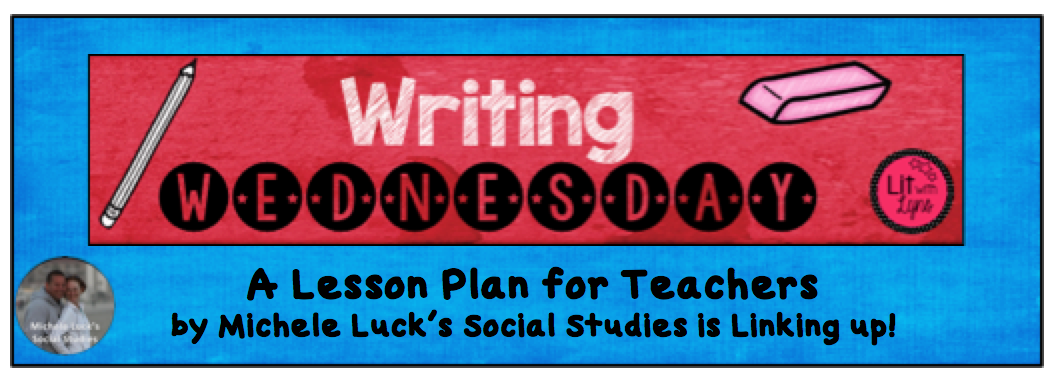
W riting in the Social Studies classroom can be a challenge. Teachers often face the reality that they have so much content to teach in so little time, and the writing process can easily be tossed out the window, sacrificed or passed back to the ELA Department.
I n my Social Studies classes, I encouraged writing from the first moment of class to the last. Using my own Interactive Notebook format, I assigned a writing prompt for each bellringer at the start and one for each wrap-up at the end. In between, I also assigned research papers, creative writing, poetry prompts , and of course, traditional essays to assess student learning.
W hile other classrooms foster creative writing, the content-based essay writing , especially in a DBQ or Comparison format, could be a headache-worthy task. It required a strong understanding of content, the application of prior knowledge, and the utilization of verified sources.
S o this month I teamed up with Lit with Lyns for Writing Wednesdays to show how I teach writing in my classes. And the tip is easy – I filled them up with SPRITE ! Not the soda, but the acronym!

T eaching with SPRITE helps students remember the major categories so important for Social Studies, but it also helps them to organize their information in a way that simplifies the writing process.
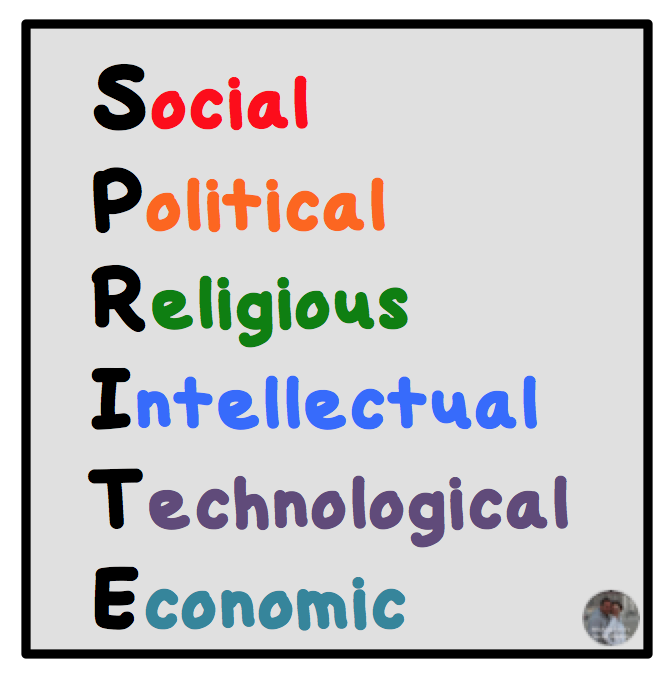
O nce the basic organizational steps are mastered, students can learn to enhance their writing to add in quotes, document analysis, and more. In my classes, enhancements had to be added for each category, and in the case of specific writing tasks (DBQ, comparison, change over time), students were charged with including those components for each category as well.

S o, here’s to writing (as I tip my cup of SPRITE)!
H appy Teaching!
147 Social Studies Topics for Your Research Project
Social studies is an integrated research field. It includes a range of topics on social science and humanities, such as history, culture, geography, sociology, education, etc. A social studies essay might be assigned to any middle school, high school, or college student. It might seem like a daunting task, but perhaps the most challenging part of the job is choosing the best topic from the many research topics in social studies. Sure, you might have a specific topic assigned to you.
Our specialists will write a custom essay specially for you!
If you’re looking for social science research topics, you’re in the right place! Custom writing experts have prepared a fresh list of ideas! This article contains 147 social studies project topics on history, culture, politics, law, migration, and other fields.
New headings & sections:
- Social Study Areas => Social Science Topics & Research Areas
- Social Studies Topics on History => Social Studies Project Topics on History
- Other Social Studies Topics => Other Research Topics in Social Studies
- 🔝 Top 10 Topics
👨🎓 Social Study Areas
🎨 social studies topics on culture, 🏛️ social studies topics on politics & governance, 🏧 social studies topics on economics & consumption, 🏺 social studies topics on history, 💡 other social studies topics, 🔗 references, 🔝 top 10 social studies topics.
- Pros and cons of monarchy.
- Is voting a civic responsibility?
- Should democracy be everywhere?
- The causes of mass consumption.
- Globalization vs. Americanization.
- The elements of personal identity.
- What are the USA’s major resources?
- Do communication technologies impact politics?
- The importance of cultural diversity in the workplace
- How do religious institutions reinforce social stability?
Social studies can be represented by ten aspects described below:
- Culture. While working with social studies, you need to understand how culture shapes our society and affects our lives. It includes learning how people create, adapt to, and share their cultural diversity.
- People and the environment. This aspect helps students create their perception of the world and how human beings interact with their environment. It is achieved through learning about different locations, people, and resources that are there.
- Production and consumption. Here, it is all about studying how people manage the production and distribution of goods. Usually, this theme is represented by subjects connected with economics.
- Time. It is mostly related to history. Therefore, students get to know about the significant events and changes that influenced our present. In addition, they learn about the beliefs and values of our ancestors.
- Identity. This theme is vital because it allows learners to understand how personal identity develops. They find out how family, culture, and friends affect people’s actions and personal growth.
- Institutions and groups. There are multiple institutions created by people: families, colleges, governments, and religious organizations. This theme lets students understand how institutions are formed and maintained and what changes they bring.
- Authority and governments. One of the essential parts of social studies is the theme of authority. Thanks to it, students can understand how different forms of governance are created. It also includes analyzing the functions and purposes of political systems.
- Globalization. Learners are helped to discover the interconnections between societies and the issues they create on a global scale. Everything is interdependent nowadays, and the importance of global connections is rising.
- Civic ideas. Students need to understand civic ideas to be fully functioning independent members of society. This vital theme includes learning about citizen’s rights and responsibilities.
- Science and technology. This aspect is not only about the development of technology and scientific achievements. It is also about how society is connected to those processes. Moreover, students learn about their impacts on people.
If you are looking for social studies project topics on the culture, you might consider the following aspects.
Every social study project would focus on how cultural attributes, such as traditions, arts, literature, are created and shared. It is important to remember to highlight both differences and similarities while doing comparative research.
Just in 1 hour! We will write you a plagiarism-free paper in hardly more than 1 hour
One of the features of culture is that it’s dynamic and continuously changing, which means it is correlated with the personal development and beliefs of citizens. Moreover, you can look into the influence of culture on different political and religious institutions.
All in all, the list of topics in social studies below is all about the interconnection between culture and society. If you’re not a fan of the listed options, you can at least take the keywords and use a generator of random topics to write about . This will give you a lot more variants to choose from.
- The principles of the multicultural policy of Australia : benefits. Australia is one of the countries that support cultural diversity. The government even created an official policy based on four principles to ensure that everybody has equal rights to participate in the community.
- Indonesian communities and ancestor worships. Practices connected to ancestor worship are based on the belief that the spirits of the dead have the powers to affect the destinies of the living.
- The domestic etiquette of modern Americans . All cultures have different etiquette – a set of rules that governs social behavior. Those norms are changing along with the culture, but can also be different depending on the social situation.
- Gender issues and women in Medieval society. In the Middle Ages, women were not allowed to receive education, had limited social rights, and had to obey their fathers’ and husbands’ will.
- Gender roles : how are boys and girls raised in American families? Gender roles enforce some specific standards and expectations of how men and women should behave. Study the socially appropriate gender roles in modern families.
- Taboos and emotions in modern society. Taboo is something prohibited from doing under the fear of punishment. Even though taboos are originally related to the sacred and spiritual practices, today, people are banned from expressing some emotions.
- How have hippies created the US? This research would focus on the ways the hippie movement made a change in the history of the country. Their cultural practices have influenced many aspects of our lives.

- Family values and religion. The family has always been considered the base of a happy American life. However, to what extent has religion affected the most common family values?
- Why does political correctness matter so much today? Political correctness means the ban on using some phrases that may be inappropriate. As a cultural phenomenon, it was created by college students in America in the 1980s.
- Is our future in social responsibility ? Social responsibility is a policy that encourages people to act for the benefit of their community and society as a whole. Could this approach help us build a better future?
One of the most important themes of social studies is about politics. When conducting science research related to this topic, you should possess a considerable amount of knowledge and experience in the issues described below.
Understanding the existing systems of governance means also knowing how political views and institutions were created. In the constantly changing world, the functions of authorities are dynamic as well.
However, you should not forget to include the relationship with citizens in this equation. Every member of society has needs, rights, and responsibilities, issues with which should also be addressed.
Receive a plagiarism-free paper tailored to your instructions. Cut 20% off your first order!
Here are some examples of social studies topics related to politics, which you may find useful:
- The American Whig party: a case study of the South. In the 19th century, the Whigs were one of two main political parties in the US. In this research, you could concentrate on analyzing the political tensions of this party in the South.
- Political parties and violence in the US. There are two major political parties nowadays. However, have you ever thought about why there are so much political violence and harsh competition between them?
- The change of the ideology of the Republican party after the Civil War. The Civil War has changed the perception of many people. It left a mark on the political views as well. Track the transformation of the Republican party’s ideology since then.
- Tory party and the British welfare under their rule. For the sake of some diversity, we have included a topic on the British political party as well. In this research, you would look into the social issues caused by the Tories.
- Is there a connection between anti-Americanism and anti-Semitic movement? Study the roots of anti-Americanism as a political view. Also, you can work on contrasting and comparing it to anti-Semitism.
- Student activism and the Black Power movement. This civil rights movement has been around for ages. For this research, you would need to study the Black Power’s topic and the student activism involved in it.
- The difficulties of the civil war in Sri Lanka. This island country has suffered the Sinhalese- Tamil conflict and the proceeding civil war. Your task would be to look into the complexities of this conflict.
- The power of Congress over presidential elections. It is one of the social science topics that requires gathering a lot of materials. You would have to analyze the Constitution and find the related cases in history.
- Voting technology: what can the law do against election fraud? Bribery and other corrupt practices in relation to the election process is not anything new. However, how can the law make a change?
- The most prominent political machines of the last decade. This paper would be interesting for students you prefer analyzing and comparing. You would need to gather information on the most prominent political machines in the US.
- A discussion of judicial independence
- Political culture in the U.S.
- A comparison of the models of democracy
- A comparison of electoral systems
- Authoritarianism vs. totalitarianism
Research topics in social studies on economics would always be related to the theme of production and consumption. You would have to understand how people manage to produce and sell goods and services worldwide.
There are multiple issues in the global economics that you, as a student, could address in your argumentative paper. It includes the unequal distribution of goods along with the growing demand.
You might as well find it interesting to research how the production of specific goods is organized and the role of technology in that process. It is also essential to look into how governments cope with market failures and how they improve the well-being of the economies.
- The flaws of the economic democracy system: a case study. Pick and analyze the issues that this socioeconomic system might have. It would be better if you add real-life cases to the analysis.
- Morality and global capitalism. Your task would be to analyze the five features of global capitalism and determine how it can be socially acceptable. Look through every moral issue that arises.
- The bankruptcy of the middle class in the US. This research focuses on the root causes, as well as consequences, of so many cases of bankruptcy among American middle-class families.
- Can we foresee the future of the European Monetary System? Ever since 1979, the Euro has been serving its purpose. However, this paper would highlight the economic factors that can lead to disruptions in this system.
- Wall Street : did we learn from the 2008 crash ? The year of 2008 punched many Americans, leaving their wealth reduced noticeably. But did we learn from past mistakes? Can we prevent the crisis from happening again?
- Understanding stock markets : profitable investments. To make a profitable investment, you need to know everything about the industry sector and stock market cycles. Compile the tips and tricks that can make it work.
- How has the Silk Road influenced the current global economy? Connecting East and West, those trade routes existed for centuries. For this cool research, you would need to analyze the current economic situation and find the features that exist thanks to the Silk Road.
- Coffee beans and fair trade . Selling coffee beans internationally, some communities and families depend on this business. However, how fair is this fair trade market? Who looks after social justice?
- Pros and cons of dollarization: a case study. Currency substitution or dollarization can’t solve the economic crisis. Study some cases of this process in different countries and analyze the benefits and problems of it.
- How to predict the exchange rate behavior? In this research, you would need to study the sources of changes in the exchange rates. You might as well look into the tools that might help predict the behavior of the rates.

- Provide real-life examples of how you or someone else plans their studies, controls pocket money, or organizes their working day.
- How organizations foster social and civic responsibility
- Crisis management post-9/11
- The growth of management in developing countries
- Conflict management in virtual and global teams
- An analysis of the benefits vs. cost of attaining a post-secondary education
- Wealth distribution and the availability of resources
- An examination of the trickle-down effect in today’s society
- Is the financial crisis of 2008 really over?
- How advertisements can create a sense of separation and association with the feminine identity
- The role of censorship in advertising
- The image of perfection in advertising
- Gender roles in advertising
- Rhetorical analysis of various marketing campaigns . How global corporations influence people’s decisions?
- Transnational organizations analytics. Determining the most appropriate and effective marketing strategies
- Advertisement analysis . The significance of the assessment in a rhetorical essay.
- Marketing reports . Explain the primary objectives of the document. When writing business or marketing essays, it is crucial to include analysis of particular examples.
- The importance of an analytical paragraph in a business essay. How does it help to define specific company’s strengths and weaknesses?
- Unethical advertising examples. What must be avoided when developing another strategy?
- Is it always worth it to spend immense amounts of money on risky advertising campaigns?
- Will the most common advertising methods work for every kind of a product?
- What issues must be considered when organizing an ad campaign?
- Positive and negative effects of advertising .
In the list of social science essay topics, there should always be at least a few questions dedicated to history. Unless we know our past, we can’t possibly understand human nature.
Get an originally-written paper according to your instructions!
For high school students, it is necessary to learn about the changes and different experiences in society. The way that values, traditions, and rules have been changing shapes our current development.
While looking for interesting social studies topics in this field, consider analyzing the root causes and consequences of different changes. Look into the ways how our social system has been developing, and you would find something exciting, for sure!
- What was the social meaning of corsets in the 20th century? Corsets are the part of the outfit that was designed to shape or modify the figure. By the 20th century, it has somewhat shaped the culture as well.
- Demystifying the stereotypes about 19th-century women in the US . There was war, and there were changes. How did the life a woman look like back then? Find the most common misunderstandings about it and conduct a historical analysis.
- African American : the historical study of social factors affecting crime. For this research, you could look into the cultural and social aspects that have influenced the response of African Americans to crimes and injustice.
- The changes in the lives of average American citizens in the 1930s. Urbanization and technological development shook the world in those years. Find out how Americans were adjusting to their new lives.
- How the environment shapes the perspective: the baby boomers ? In the example of the baby boomers’ generation, study the effects of the social and cultural aspects on identity and personal values.
- The process of development of Italian fashion and the US. You would be studying the historical facts in support of the idea that the US played an essential role in the Italian fashion industry development.
- Generation X and global leaders. This topic focuses on the most prominent world leaders in different areas. Your task would be to find the connection between the personal specifics of generation X and global leaders.
- Women in the Victorian Age and domestic rules. Conduct research on the ideology of Victorian women. What social challenges connected to industrialization were they forced to face?
- Servants in the American houses in the middle of the 20th century. In the 1920s, women started quitting their housewives’ chores and hiring servants to do them instead. You would look into the social sources of such a change in the domestic life of that time.
- What is the connection between social change and the American schooling system? Look into the development of the educational institutions in the US over a chosen period. Find out what social factors have affected the process.
- Civil disorders
- Political terrorism
- Non-political terrorism
- Limited political terrorism
- Expand on the problem of democracy and domestic terrorism
- A study of terrorist groups
- State-sponsored terrorism
- The tactics of terrorism
- The history of terrorism
- The causes of terrorism
- Responses to terrorism and counter-terrorism global policy
- For more topics ideas, check out Research Guide for Students .
- How enlistment in the U.S. Army works
- The top five army bases
- Customs and courtesies in the military
- The history of Memorial Day
- The threat of homelessness for veterans
- Turkic migration
- Mongol invasions
- Great migration of the 1630s
- Great migration of African Americans
- Government regulations
- Socially irresponsible corporations
- Antitrust provision
- International business law and legal regulations for international corporations and companies
- Business law in the Islamic world and how it differs from that of other countries
Criminology
- Crime prevention
- Juvenile delinquency
- Victimology
- Deviant behavior
When you write an essay on justice, you have a great opportunity to present your opinion on the subject. Here are some potential topics:
- Justice: A Myth or Reality?
- Tell about today’s idea of justice. What do people do to establish justice in the world?
- Give your reasons why absolute justice is impossible.
- How justice is portrayed in Crime and Punishment by Dostoyevsky
- Discuss the Heaven Justice
Gender Studies
- Women and the Taliban
- Chinese women as seen through the Chinese culture
- Women and Confucian cultures in Korea
- Witch hunts in the Western world
- The influence of feminism on men
- The challenge of feminist biblical interpretation
- Gender identity and the particulars of word-of-mouth communication
- How leadership styles differ based on gender
- Women empowerment
- Why do women think that their rights are neglected in free countries?
- Gender inequality : are men more likely to receive well-paid jobs than women with precisely same characteristics?
- Are men considered to be better employees than women ?
- Can feminists persuade the government to make changes in the law beneficial for them?
- Gender discrimination in everyday life
- The purpose of feminist demonstrations
- Are people concerned about the problem of gender inequality in their everyday lives?
- Where are the human rights of women neglected and why?
- Causes of gender inequality
- Is the factor of overall equality necessary for the development of the world or not?
- What are the most popular examples of equality among citizens of one country?

- Gender stratification definition. Where can it be observed in the modern society?
- What can be changed because of mass feminism?
- Gender stereotypes . Is everything that we hear about discrimination right?
- What is gender stratification ?
- Are females discriminated in the modern society, or this issue is fabricated?
- Gender roles in the workplace
- Factors contributing to gender inequality
- Disadvantages of gender equality
- Gender equality theory
- Gender imbalance definition. What is the origin of the term and where it is used?
- Gender superiority. Is it true that males were always dominant figures in the history?
- History of gender discrimination . Was this societal rule present in the prehistoric times, and when it was introduced?
- Gender disparity definition. What is the origin of the term and where it is used today?
This might be interesting for you:
- Funny Informative Speech Topics and Ideas for Presentation
- A List of Informative Speech Topics: Best Creative Topic Ideas
- Good Informative Speech Topics: How to Get Thunders of Applause
- Best Science and Technology Essay Topics to Write About
- Satirical Essay Examples and Best Satire Essay Topics
- 309 Human Rights Research Topics & Essay Ideas
- Organizing Your Social Sciences Research Paper: The Introduction
- Social Studies Education Topics at Questia
- National Curriculum Standards for Social Studies: Executive Summary
- Social Studies Topics at BrainPOP
- Social Studies Research Project Topics
- Social Studies Fair
- About Behavioral and Social Sciences Research
- 11 Smart Sociology Research Topics That Will Get You an A
- Reflective Essay On Social Studies
- Social Work Personal Statements
- Scientific Reports
- Social Work Research Guides
- Social Work Literature Review Guidelines
- How to Survive Peer Review in Social Sciences and Humanities
- Behavioral and Social Sciences Resources
- Social Studies Topics at Flocabulary
- Social Studies Lessons at TED-Ed
- Share to Facebook
- Share to Twitter
- Share to LinkedIn
- Share to email

If you are about to go into the world of graduate school, then one of the first things you need to do is choose from all the possible dissertation topics available to you. This is no small task. You are likely to spend many years researching your Master’s or Ph.D....

Looking for a good argumentative essay topic? In need of a persuasive idea for a research paper? You’ve found the right page! Academic writing is never easy, whether it is for middle school or college. That’s why there are numerous educational materials on composing an argumentative and persuasive essay, for...

Persuasive speech is the art of convincing the audience to understand and trust your opinion. Are you ready to persuade someone in your view? Our list of sports persuasive speech topics will help you find a position to take and defend. If you need more options quick, apart from contents...

When you look for a good research paper topic, you can easily become the severest critic of any proposed idea. Some topics do not interest you at the very least, while others might shock your teachers. Where is the golden mean? Check out this list of top 100 research paper...

Can there possibly be anything fun about academic writing? It seems there is – what are all those fun persuasive speech topics then for, after all? However, creating a bunch of good topics might seem hard the first time around. No need to worry though – there’s always plenty of...

A persuasive speech on any topic is a performance designed to convince people about something and prove your point. Choosing a suitable topic is crucial for your speech’s success. Do you need some help with finding easy topics for a persuasive speech? Then check these fantastic and easy ideas from...

A proposal argument is an essay in which you describe a specific issue that needs fixing. It focuses on problem solutions. Are you interested in writing high-quality proposal essays? Or maybe you’re wondering what can make your writing truly outstanding? Here you will find answers to these questions as well...

Sometimes you just wish there was a marketplace with vendors shouting, “Topics for argument essays! Who wants inspirational topics to write about?” Well, you are lucky enough: you’ll find plenty of inspiring things here! Coming up with some argument essay topics is quite easy! In this article, you’ll find some...

Are you searching for original, thought-provoking, and really controversial debate topics? Here they are! Selecting any of these 25 controversial topics for debate from Custom-writing.org, you can guarantee a heated dispute in class or exciting polemics with your friends. But first, let’s figure it out, what is debate and how you should pick up great...

Perhaps, each person has unforgettable memories of school life. It might be their first day when everything seemed to be exciting and unknown. Or it might be some picnic or trip when they spent a great day outside with their classmates. Writing a high school experience essay requires you to...
![social studies essay writing 205 Essay Topics for Grade 8, 9, 10, 12 + Writing Tips [2024]](https://custom-writing.org/blog/wp-content/uploads/2021/01/student-writing-essay-while-sitting-e1565284963989-284x153.png)
We came up with this guide to make school essay writing easy for you. Need some creative writing topics for grade 8? Or recommendations for the 11th-grade expository paper? We’ve got you! Helpful tips and essay topics for grades 8, 9, 10, 11, and 12— our Custom-writing.org team has advice for everyone. Here, you’ll find: 205 great essay ideas; tips on how to write argumentative and persuasive papers. In fact, our recommendations will be...

Have you ever thought about the importance of transportation? Every day we see cars, trucks, planes, and ships and never wonder what exactly they are doing. In fact, these vehicles not only transport people from one place to another. They also form a vast system that plays a vital role...
Such an inspiring and candid glimpse into the life of a great man, Fred Hampton!! May he rest in Black Power!

Thank you for your feedback!
what can be the subject for exam fear
I am impressed!
I like those topics. How can I get the material?
I believe you can use some tips from this article .
- Entertainment
- Environment
- Information Science and Technology
- Social Issues
Home Essay Samples Science
Essay Samples on Social Studies
Ruth benedict: shaping anthropology through cultural relativism.
The essay will assess Ruth Benedict’s contribution to anthropology, including how important her exploration into culture and personality was because it led to her most important work in abnormalities. It will explore criticism about the incommensurability of cultures and “the savage slot”, which is captured...
- Anthropology
- Cultural Relativism
- Social Studies
Early Biological and Physical Anthropology Role in Anthropology
Early biological and physical anthropology are both a branch of Anthropology, it is the study of human evolution and development to environmental stressors. In this essay both early biological and physical anthropology will be discussed to achieve a better understanding of these concepts. This essay...
History and Implications of Educational Anthropology in India
Anthropology is the study of humans, their cultures and societies. It is the study of the others or the unfamiliar, the unfamiliar is made familiar and brought to the forefront by anthropologist. Anthropology is subdivided into four main categories: archaeological; biological; linguistics; cultural. Anthropology in...
MGH301 Epidemiology and Biostatistics with Special Reference to Social Epidemiology
The process of understanding how to include social epidemiological theories into a project can be met with a lot of complexities. Methods which can even provide the most evidenced based on other health interventions is often inappropriate when issues such as mental illness is under...
- Epidemiology
- Research Methods
Best topics on Social Studies
1. Ruth Benedict: Shaping Anthropology through Cultural Relativism
2. Early Biological and Physical Anthropology Role in Anthropology
3. History and Implications of Educational Anthropology in India
4. MGH301 Epidemiology and Biostatistics with Special Reference to Social Epidemiology
Stressed out with your paper?
Consider using writing assistance:
- 100% unique papers
- 3 hrs deadline option
- Space Exploration
- Endangered Languages
- Kinesiology
- Construction Management
Need writing help?
You can always rely on us no matter what type of paper you need
*No hidden charges
100% Unique Essays
Absolutely Confidential
Money Back Guarantee
By clicking “Send Essay”, you agree to our Terms of service and Privacy statement. We will occasionally send you account related emails
You can also get a UNIQUE essay on this or any other topic
Thank you! We’ll contact you as soon as possible.
Social Studies Essay Writing

- Easel Activity
What educators are saying
Also included in.

Description
This packet of tips, do's and don'ts covers everything your students need to know about writing a document-based or thematic essay!
★ If you are interested in teaching your students how to implement primary/secondary sources in their writing, find my Primary and Secondary Sources packet, HERE!
Included in this resource:
• Essay Writing in Social Studies Cover page
• Essay Writing in Social Studies cover page for students
• Common Key Action Words Page
• Thematic Essay "Tip Sheet"
• Document-Based Question (DBQ) "Tip Sheet"
• Writing a "good" DBQ body paragraph that includes documents & outside information
• Transitional Words and Phrases sheet
• Rules of Writing: Do's & Don'ts
• Interactive Notebook notes pages
★★ Please NOTE: I am a teacher from New York where our students are required to learn to write DBQ's and Thematic Essays. You and your state may call the essays something entirely different! It is a great tool for your students no matter what you call the essays!
★ I spend two to three days and go over this entire packet with my students. Then, I print in color and laminate the packet and keep it posted in my classroom year-round!
★★ Looking for the digital, 1:1 version of this resource? Find it here!
Social Studies Essay Writing Google Drive ASSL
If you would like more information on how to execute this lesson/activity in your class, please email me at [email protected].
Digital Papers by Erin Bradley
Clipart by Melonheadz & Original Illustrations by KERRI WEBB - Kerri's Art Corner
Fonts by Kimberly Geswein & Kevin & Amanda
© 2012 A Social Studies Life
For personal use only. Duplication for an entire school, an entire school system, or for commercial purposes is strictly forbidden. Please have other teachers purchase their own copy. If you are a school or district interested in purchasing several licenses, please contact me for a district-wide quote.
Questions & Answers
A social studies life.
- We're hiring
- Help & FAQ
- Privacy policy
- Student privacy
- Terms of service
- Tell us what you think

IMAGES
VIDEO
COMMENTS
Writing a strong paper in Social Studies requires, before all else, a clear understanding of the arguments of the theorist or theorists that the paper topic asks you to address. Indeed, in some ways, the work of writing a Social Studies 10 paper begins from the first moment you pick up each theorist's writings.
Your teacher provides guidelines on writing format for your social studies essay; however, Chicago/Turabian style is a good choice for history, geography and sociology papers. If you use Chicago author-date style, you will prepare a bibliography of the sources you consulted to research and write your paper.
The deceptively easy answer to this question is that—because writing a thesis is required of all Social Studies concentrators—you have to write one. However, we hope you will not focus on this answer (that is, that the thesis is required) as a reason to avoid thinking about the benefits and challenges of thesis writ-ing.
Show students how people in the real world write every day, some for a paycheck and others just for fun. Tell them that their ideas matter and their words hold more power than they may ever know. Try to get students to glimpse the joys of writing. To understand how it sharpens the mind, softens the heart, and feeds the soul.
Here's why it's a game-changer: 1. Deeper Engagement. Writing prompts students to engage with historical events and figures on a profound level. It prompts them to analyze and internalize the subject matter. 2. Critical Thinking. When teachers integrate writing, students develop critical thinking skills.
However, these same basic steps work for all types of history and social studies writing: end-of-unit essays, on-demand DBQs or LEQs, and formal research papers. This is my 6-step how-to guide for scaffolding your history and social studies students in outlining an essay: 1. Deconstruct the essay prompt. 2. Recap the truths, not just the content.
41 Social Studies Writing Prompts. Social studies are an important part of your education. Learning about the social sciences gives you a better understanding of the world we live in today by studying the events of the past. Reading and then writing about what you learn will give you a better understanding of the past.
Today's post is written by Cheney, Kansas middle and high social studies teacher Jill Weber. Jill is the 2016 Gilder Lehrman Kansas History Teacher of the Year. Gone are the days in which reading novels and writing essays belonged solely in an ELA classroom. All subjects are now expected to (and should) be integrating and supporting…
Writing in social studies involves exactly this process, synthesizing the perspectives of many to discover what happened and why. ... Write an essay expressing your opinion and use evidence from the documents to persuade your generation. Keeping that prompt in mind, students should closely read these two documents. Ask them to think about the ...
Social Studies Essay Topics. From rock music to criminal justice, and from metaphysics to film analysis, teachers can draw on our bank of social studies essay prompts and questions to help ...
School: Harvest Collegiate High School, New York, NY. Grade: 10. Discipline: History/Social Studies. Lesson Topic: Writing about complicated things ("It's Complicated") Lesson Month: March. Number of Students: 20. Other: Theme-based semester-long elective course in the history discipline. "It's Complicated" focuses on current world ...
Most writing in the social studies classroom is either formative or summative assessment. But writing can also be used to learn and explore the material. ... Using prior knowledge and the available documents, students write an essay. DBQs cover document analysis and teach students to synthesize information in a logical, concise manner.
on writing, critical thinking and other suggestions. Books: Writing for the Social Studies, McDougal Littell, 1998, Evanston, Il. ISBN #0-395-86909-9 A excellent resource for the teacher and student. Combines suggestions, ideas, how to's and samples to teach report writing, essay writing, and research papers. Sensenbaugh,Roger.
This study examined the effectiveness of Self-Regulated Strategy Development (SRSD) to improve students' ability to write expository essays after reading social studies text. Third-grade general education teachers (N = 14) were randomly assigned by clusters to SRSD or a business as usual control condition. One hundred and eighty consented students participated in the full study. Teachers in ...
Integrating writing activities into a social studies unit is actually fairly easy. Writing can be as simple as summarizing the key points of a lesson to as complicated writing a higher-level essay. Daily writing could include: Summarizing a text or presentation. Bulleted facts and data from the text or presentation.
STEP 1: Tip: Look closely at your Social Studies Curriculum and Standards. Make a list of the Strands/Topics you are expected to cover. Read about what exactly you are suppose to deliver instruction on. As a 5th Grade ELA teacher, my partner and I share Social Studies instruction for our two homerooms.
The written responses in this document are examples of Social Studies 30-2 diploma examination writing that received scores of Satisfactory (S), Proficient (Pf), and Excellent (E). These example responses are taken from the January 2016 Social Studies 30-2 Diploma Examination. Along with the rationales that accompany them, they should help ...
I n my Social Studies classes, I encouraged writing from the first moment of class to the last. Using my own Interactive Notebook format, I assigned a writing prompt for each bellringer at the start and one for each wrap-up at the end. In between, I also assigned research papers, creative writing, poetry prompts, and of course, traditional ...
Social studies is an integrated research field. It includes a range of topics on social science and humanities, such as history, culture, geography, sociology, education, etc. A social studies essay might be assigned to any middle school, high school, or college student. It might seem like a daunting task, but perhaps the most challenging part ...
A guide on the basics of writing a Social Studies essay
Essay Samples on Social Studies. Essay Examples. Essay Topics. Ruth Benedict: Shaping Anthropology through Cultural Relativism. ... Our goal is to help students excel in academic writing and successfully graduate. Find new ideas and inspiration using our free samples.
Social Studies Essay Writing BUNDLESocial Studies Essay WritingWriting Document-Based Question Essays & Thematic Essays in Social StudiesHardcopy and Google Drive Resource Included This packet of tips, do's and don'ts covers everything your students need to know in writing a document-based or th. 2.